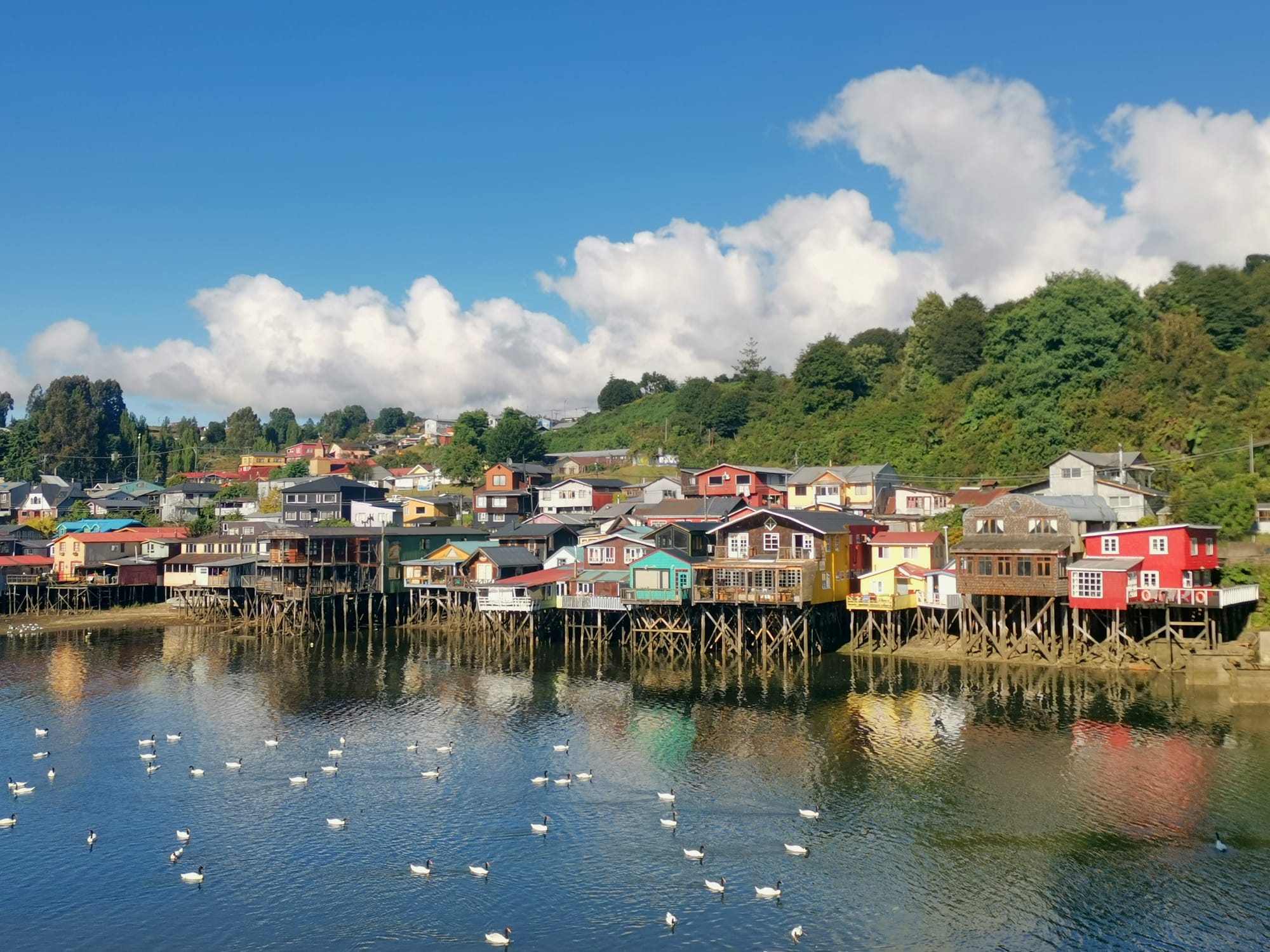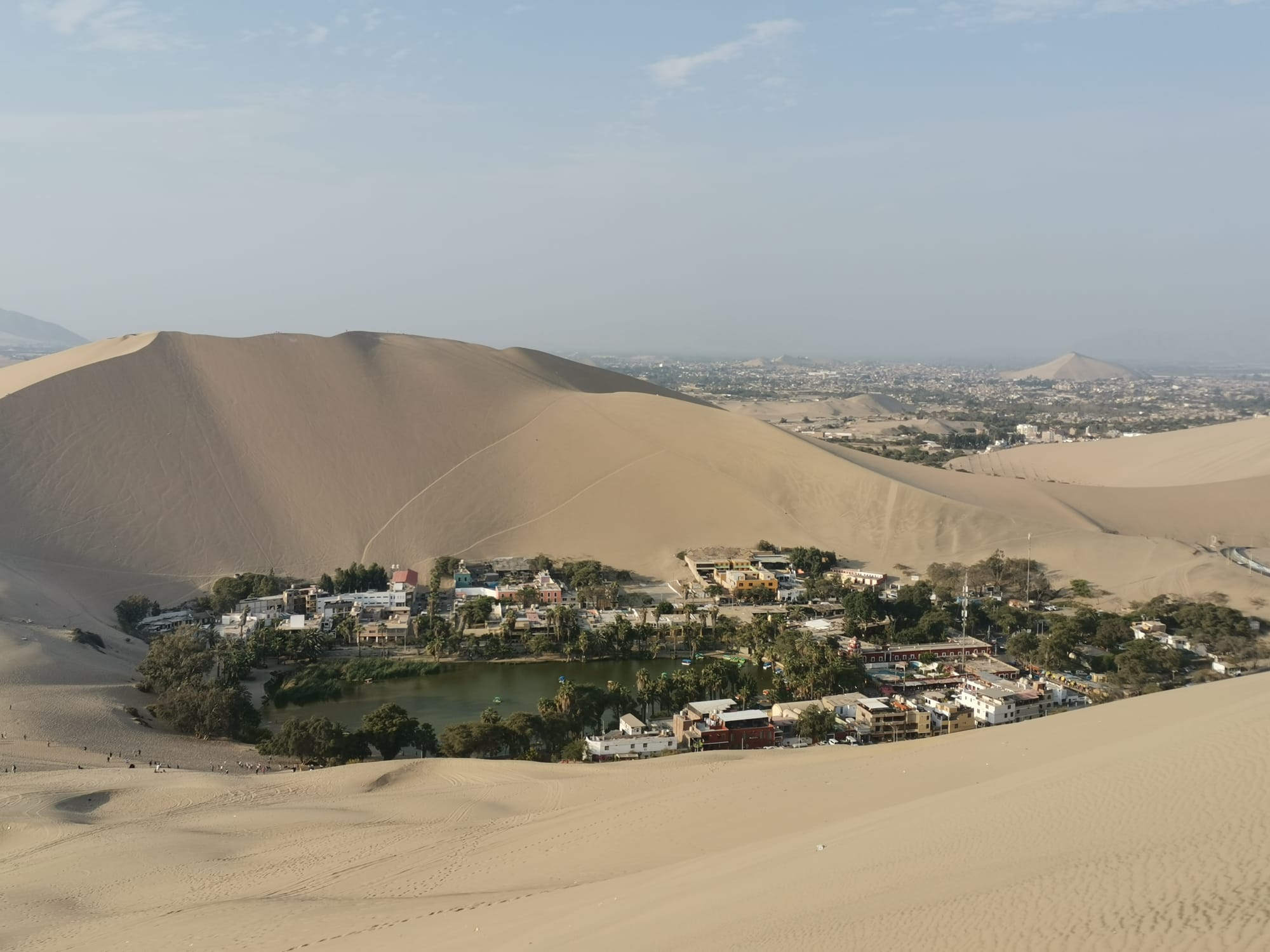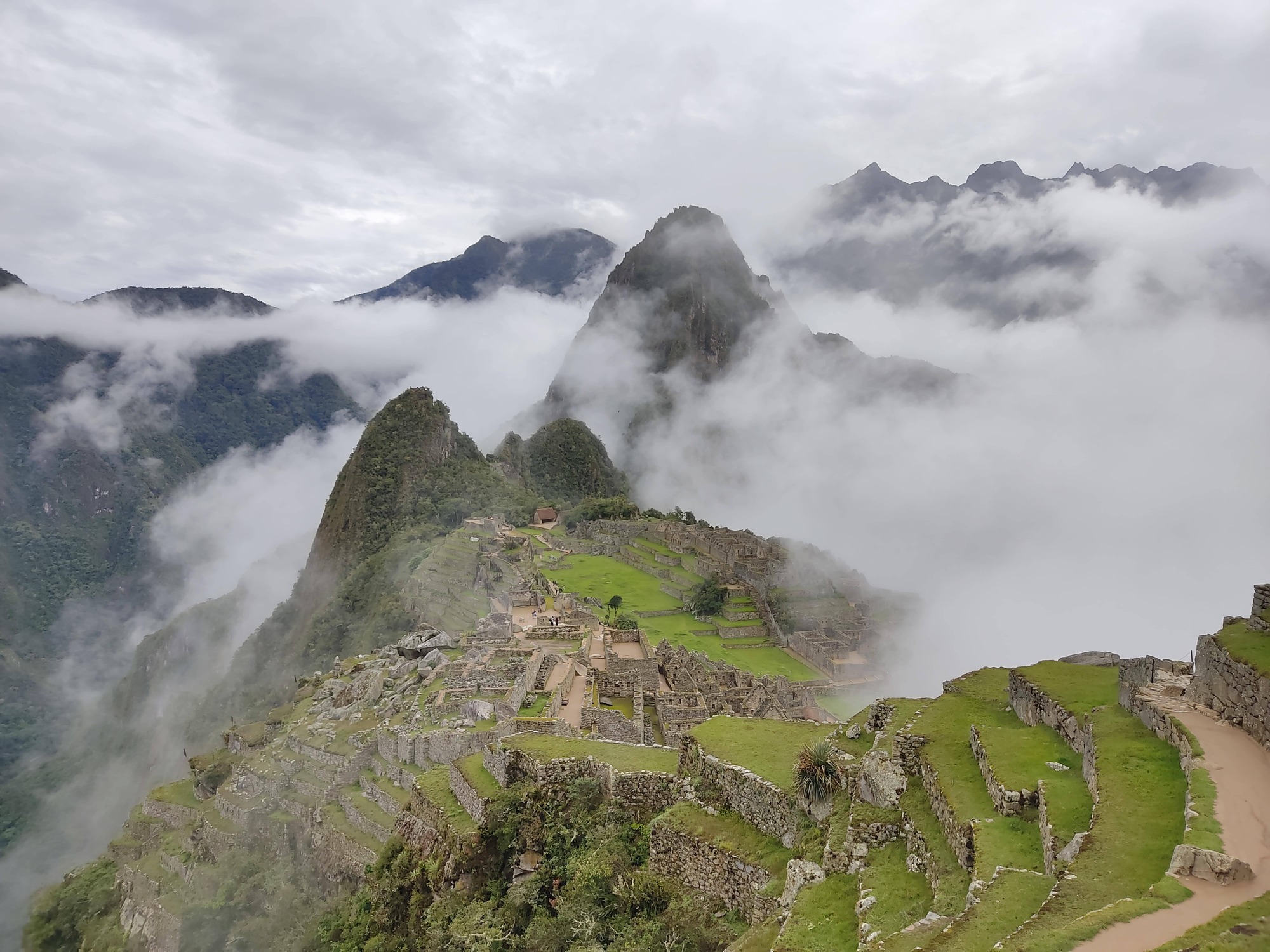Introduction
On our road trip south towards Patagonia, we knew we would encounter some breathtaking scenery, but we weren't prepared for quite how suddenly it would arrive. The Chilean Lake District is located between Santiago and Patagonia, and is a fairy-tale land of waterfalls, volcanoes, beaches and forests. Surrounded by vivid green plants, turquoise rivers and deep blue lakes, the towns nestled within this untouched wilderness consist of cosy log cabins, eqipped with wood-burning stoves to combat the chilly nights despite the hot midsummer days. The small wooden houses, bright flowery meadows, and pleasant climate make this region feel very similar to some of Europe's most picturesque places. Although the region is understandably very popularWe visited the Lake Distric during Christmas, which is the biggest holiday in South America. This meant that every town was full of families from the north of Chile, who were enjoying some of their country's impressive sights over the festive period. It is less busy during the winter, but the weather is much less hospitable. with internal tourists, this section of paradise remains shockingly unknown to people from overseas, offering far more chances to engage with the locals than to join international tour groups.
Pucon
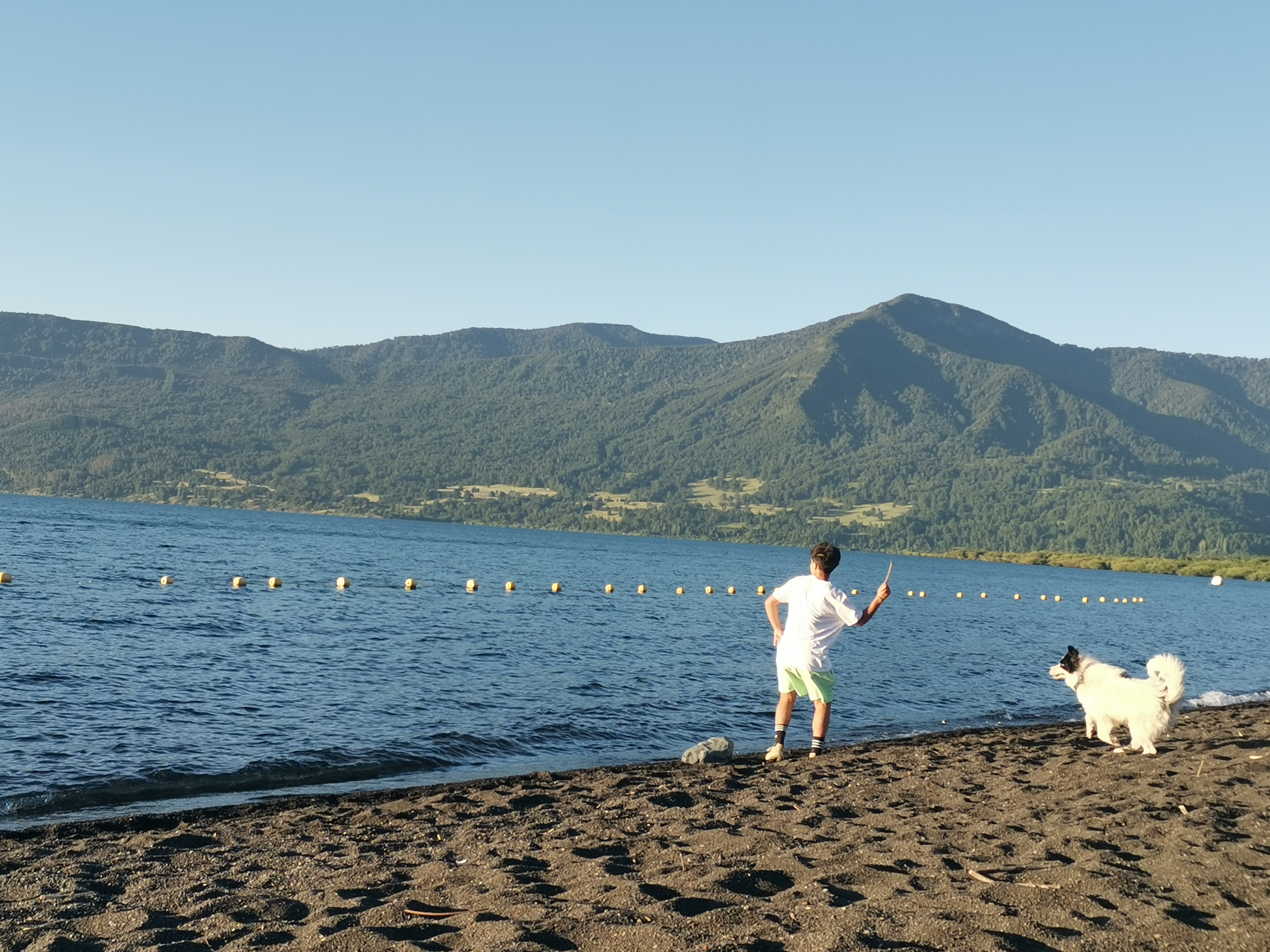
Pucon
Pucon is often described as a heaven for people who love the outdoors, and we are inclined to agree. This small, cosy town is nestled on the shores of the large Villarrica Lake, where the snow-capped Villarrica volcano constantly looms overhead. The atmosphere is relaxed and welcoming, with numerous family-run corner shops, tourist agencies, artisanal markets, and a small harbourThe Harbour The harbour is the main focal point in town, and has one of the best views of Volcan Villarrica. Although we never saw one of the boats leave, we suspect they are to take tourists on trips around the beautiful lake. where a few wooden boats are moored in the calm water. Pucon is something of a gateway into the Lake District, located close to several large lakes, countless volcanoes, and a network of rivers meandering through the acres of pine forests.
The harbour is the main focal point in town, and has one of the best views of Volcan Villarrica. Although we never saw one of the boats leave, we suspect they are to take tourists on trips around the beautiful lake. where a few wooden boats are moored in the calm water. Pucon is something of a gateway into the Lake District, located close to several large lakes, countless volcanoes, and a network of rivers meandering through the acres of pine forests.
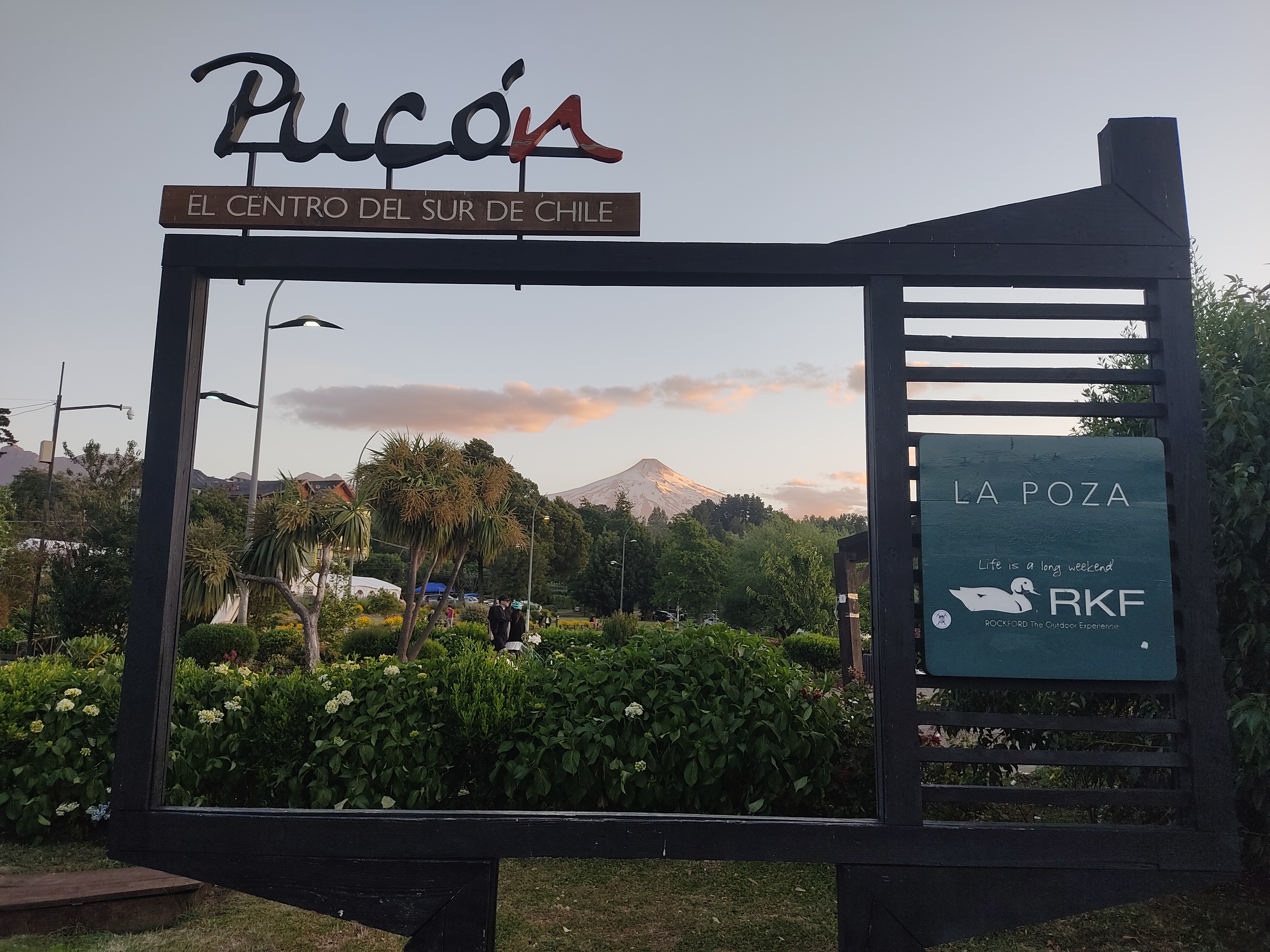
The town itself is on the shores of Lago Villarrica, with a large beach just a 10 minute walk from the centre. Locals gather here most evenings, to enjoy the black volcanic sand and pristine views of the still water and surrounding hillsides. Further afield, Playa Blanca is known for its soft white sandsThe sand at Playa Blanca appears white when compared to the surrounding black volcanic beaches. However, in reality it is more like a typical golden/brown sand beach., on the shores of lake Caburgua, and is a popular spot for families. If relaxing on the shores of the lakes, with volcanoes and mountains in the background seems too laidback, there is a plethora of rafting and watersports activites available in the many rivers and lakes. Additionally, there is a local bus which provides services to the Huerquehue National park, which is supposed to have some beautiful hikes through the forests. You could almost spend a lifetime in Pucon and never run out of new adventures to do or sites to see.

Climbing Volcan Villarrica (and sliding back down)
The first thing you will notice when visiting Pucon is the ever present Volcan Villarrica on the horizon, with its snow-capped peak gently releasing plumes of gas into the sky above the sleepy town. As intimidating as it first appears, Volcan Villarrica is actually relatively easy to climb without any prior mountaineering experience, and hands-down the most rewarding thing to do in Pucon. If the challenge of climbing an activeVillarrica is one of the most active volcanoes in Chile, and there is an eruption warning indicator in the town that is updated regularly. Although large eruptions are rare, smaller volcanic releases are very frequent, and so some days climbing to the summit is not permitted due to safety concerns. We couldn't get closer than 300m from the caldera when we went, and lava was seen erupting from the volcano less than a week after we left Pucon. volcano isn't enough incentive, the panoramic views of the incredible Lake District from the top, and the thrill of sliding back down the icy slopes on a plastic sledge certainly will be.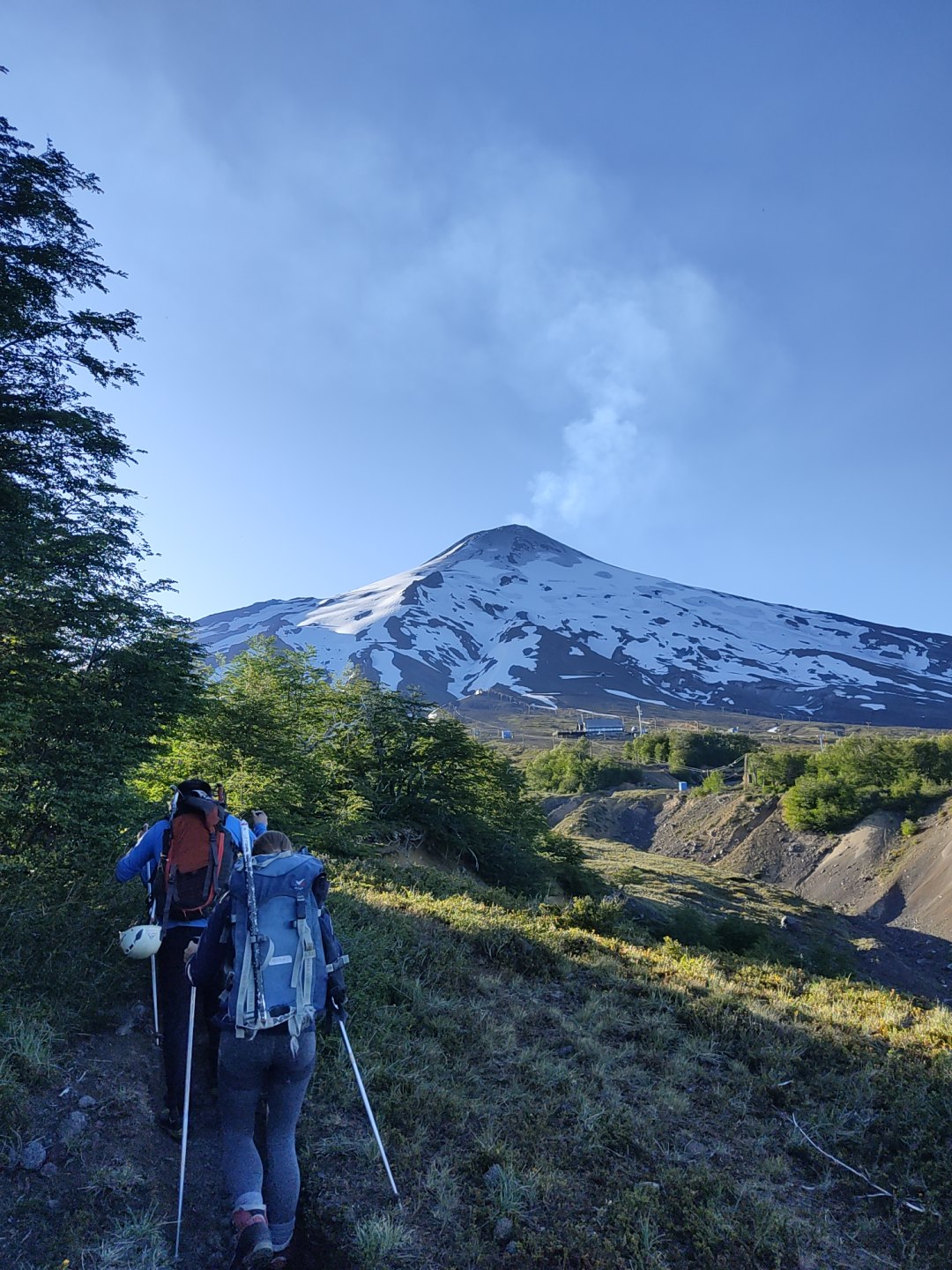
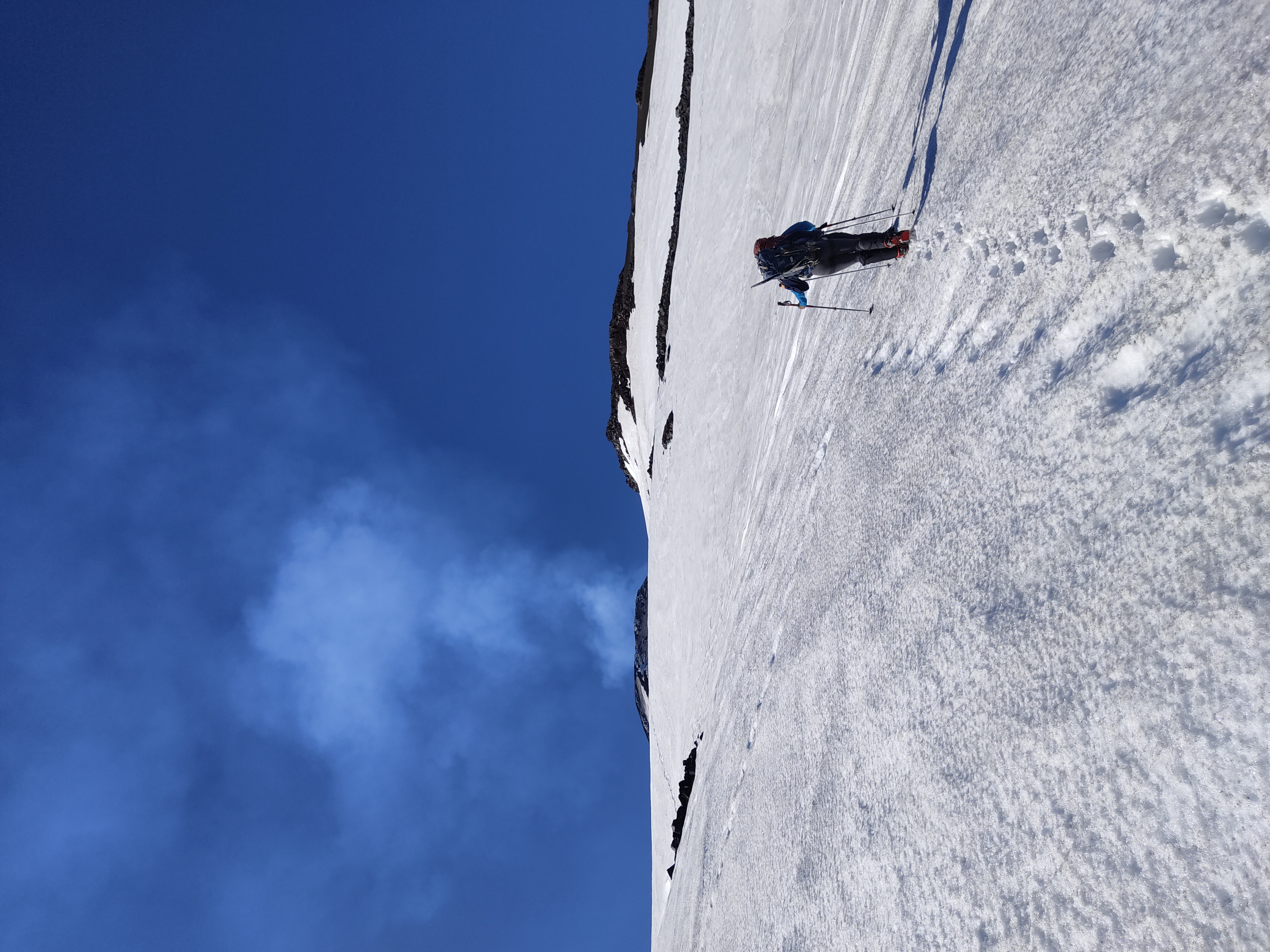
The climb is a 4 - 5 hour hike, starting out on loose and rocky terrain in the early morning chill. Although the barren hillside is quite monotonous, it doesn't take long before the panoramic views of the surrounding area appear. The volcano is located within a pine forest, but from its slopes you can see over the mountains, valleys, and rivers to the huge lakes beyond - and the views keep gettting better as you climb higher. The second half of the climb covers the steep, slippery icecap towards the summit. Although we had no experience climbing on snow or ice before, the tour company provide all the equipmentSuited and Booted
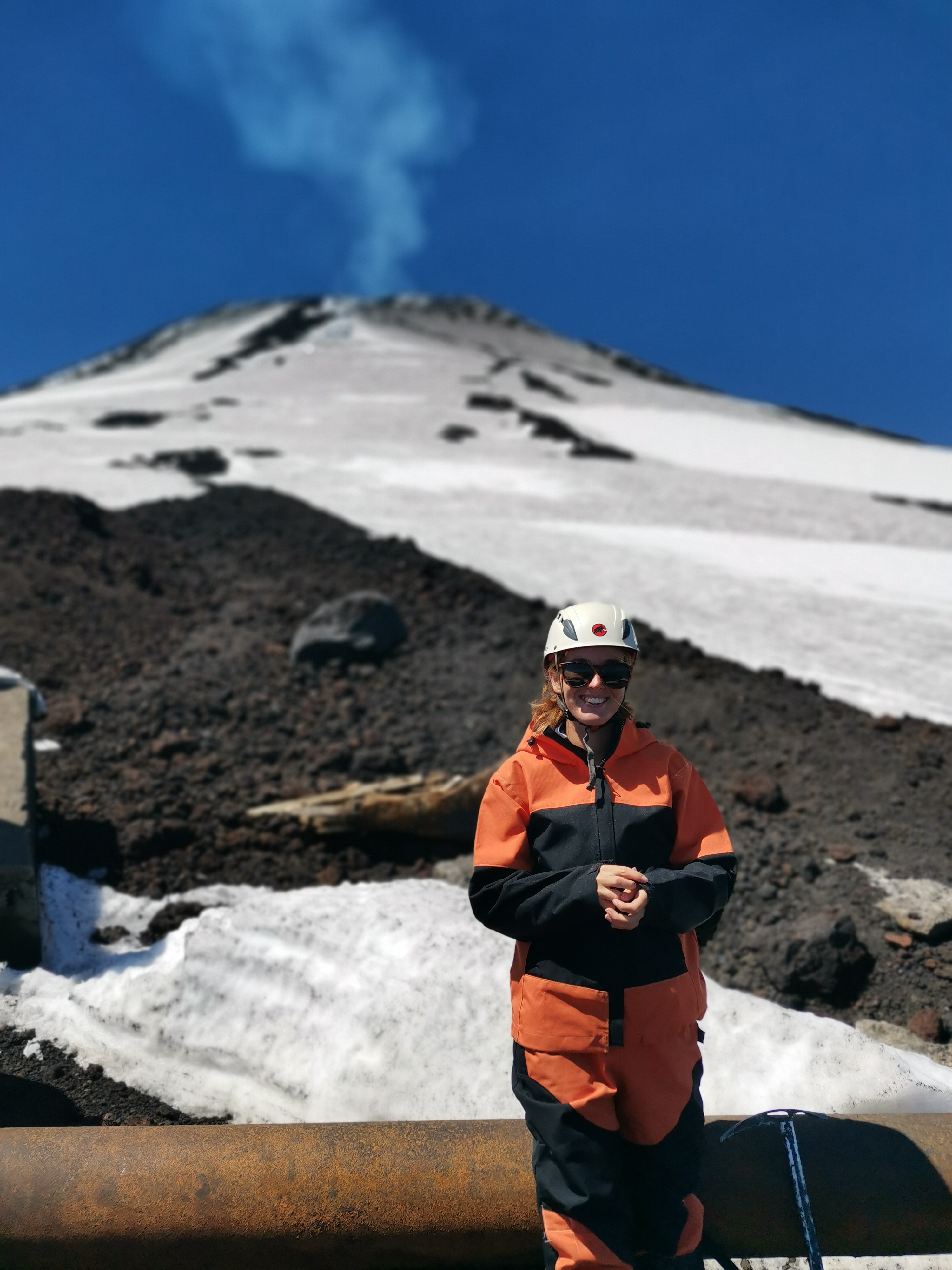 The hike really is beginner-friendly, with so much equipment provided, such as waterproof overalls, gators, hiking boots, crampons, walking poles, and an ice-axe. , and help you try out walking with cramponsCrampons
The hike really is beginner-friendly, with so much equipment provided, such as waterproof overalls, gators, hiking boots, crampons, walking poles, and an ice-axe. , and help you try out walking with cramponsCrampons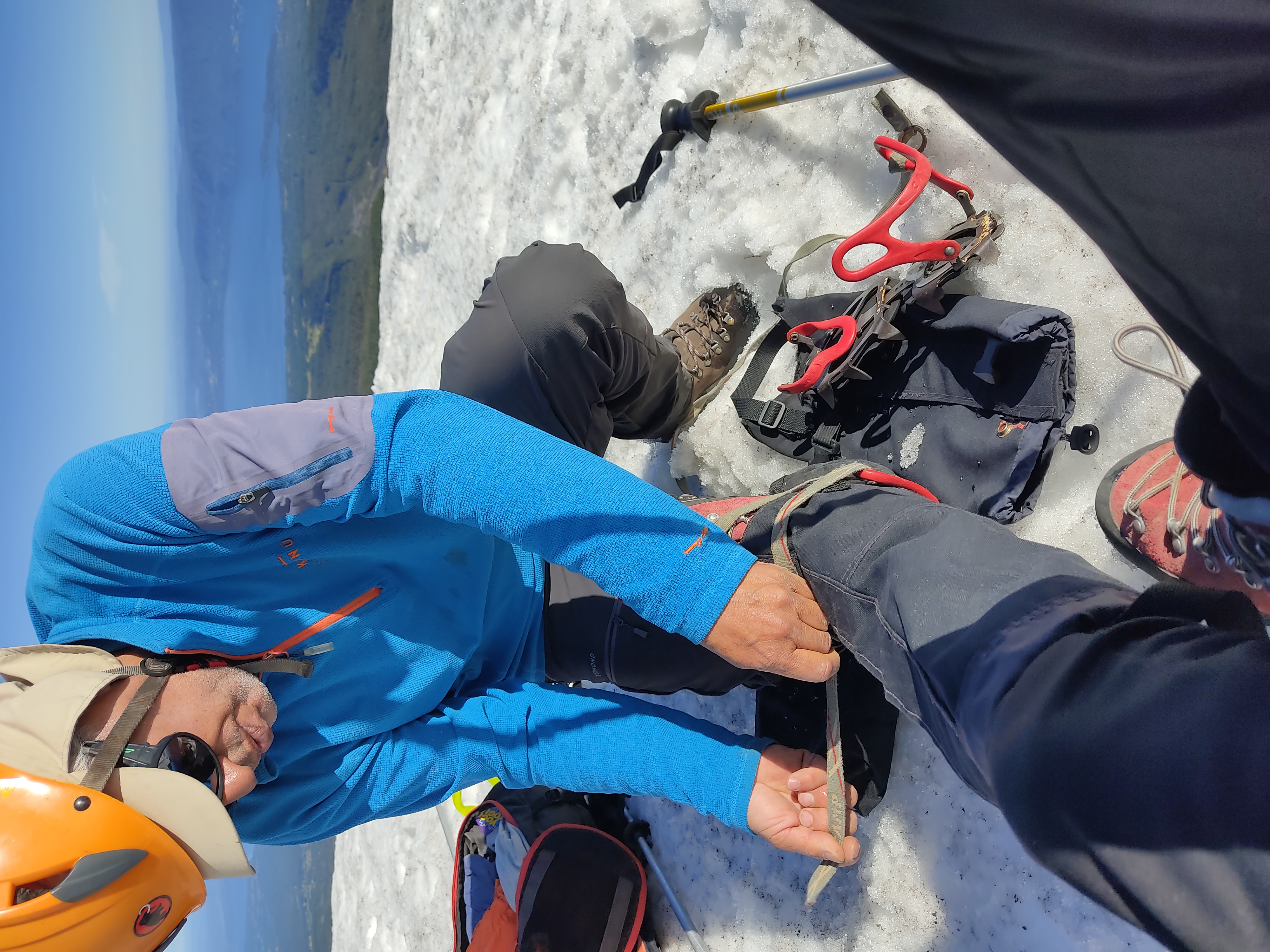
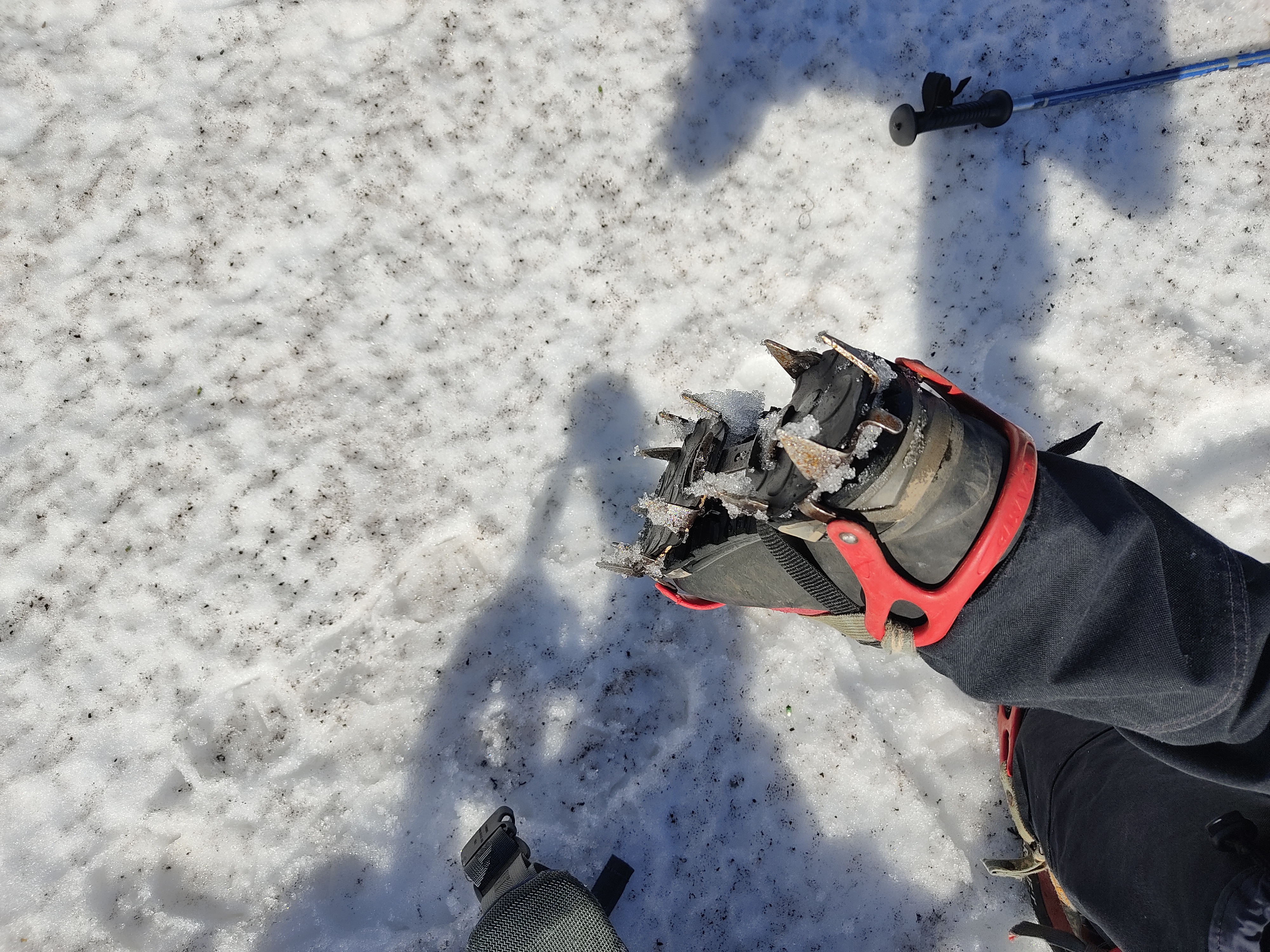 One of the reasons this hike is so fun is because it is a great opportunity to use crampons and climb through the ice, without having to go on a long expedition up to crazy altitudes.. We slowly zig-zagged our way up towards the summit, stopping frequently to take in the views and the unusual contrast between the cold snow and the smouldering volcano ahead.
One of the reasons this hike is so fun is because it is a great opportunity to use crampons and climb through the ice, without having to go on a long expedition up to crazy altitudes.. We slowly zig-zagged our way up towards the summit, stopping frequently to take in the views and the unusual contrast between the cold snow and the smouldering volcano ahead.
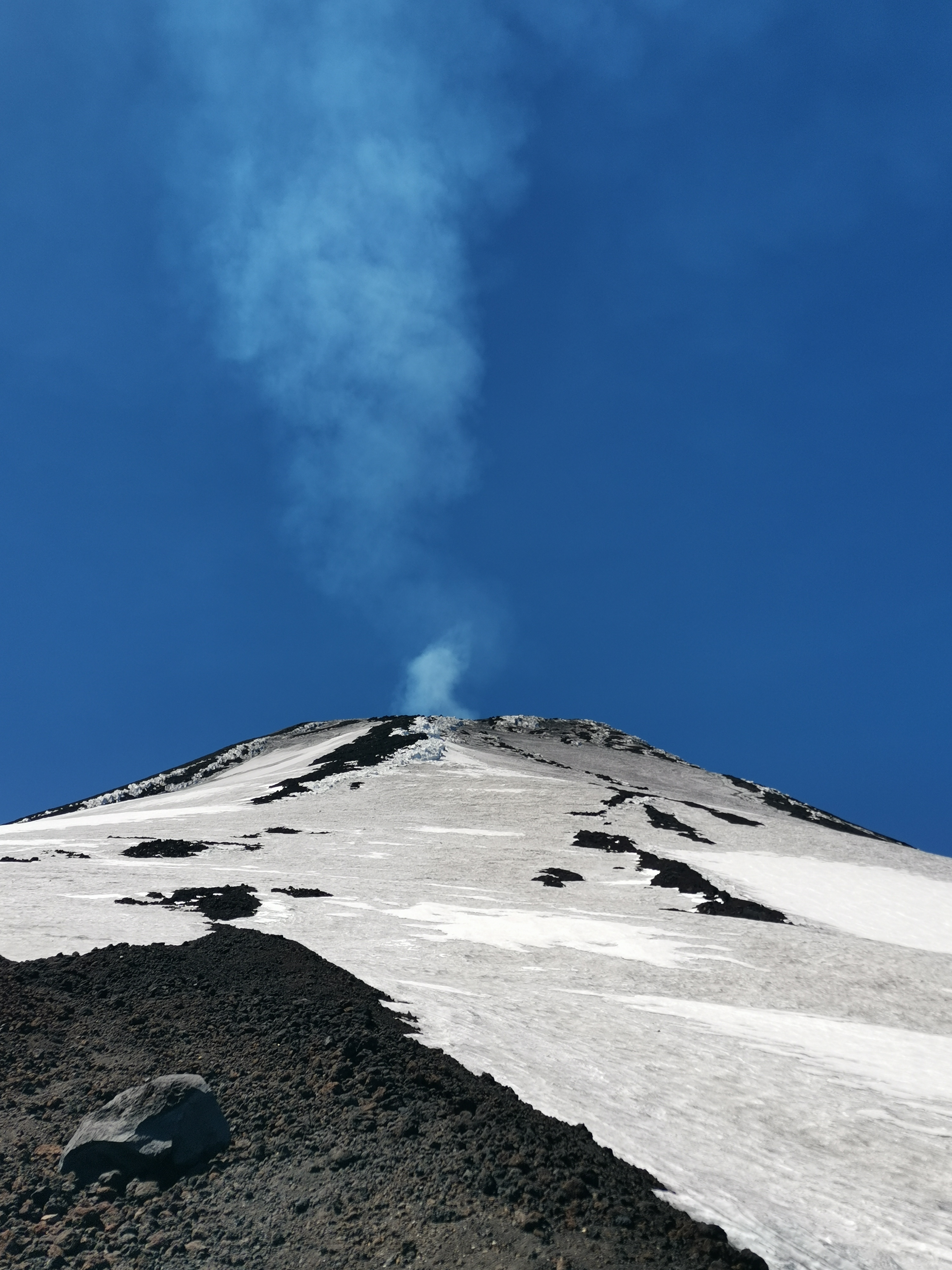
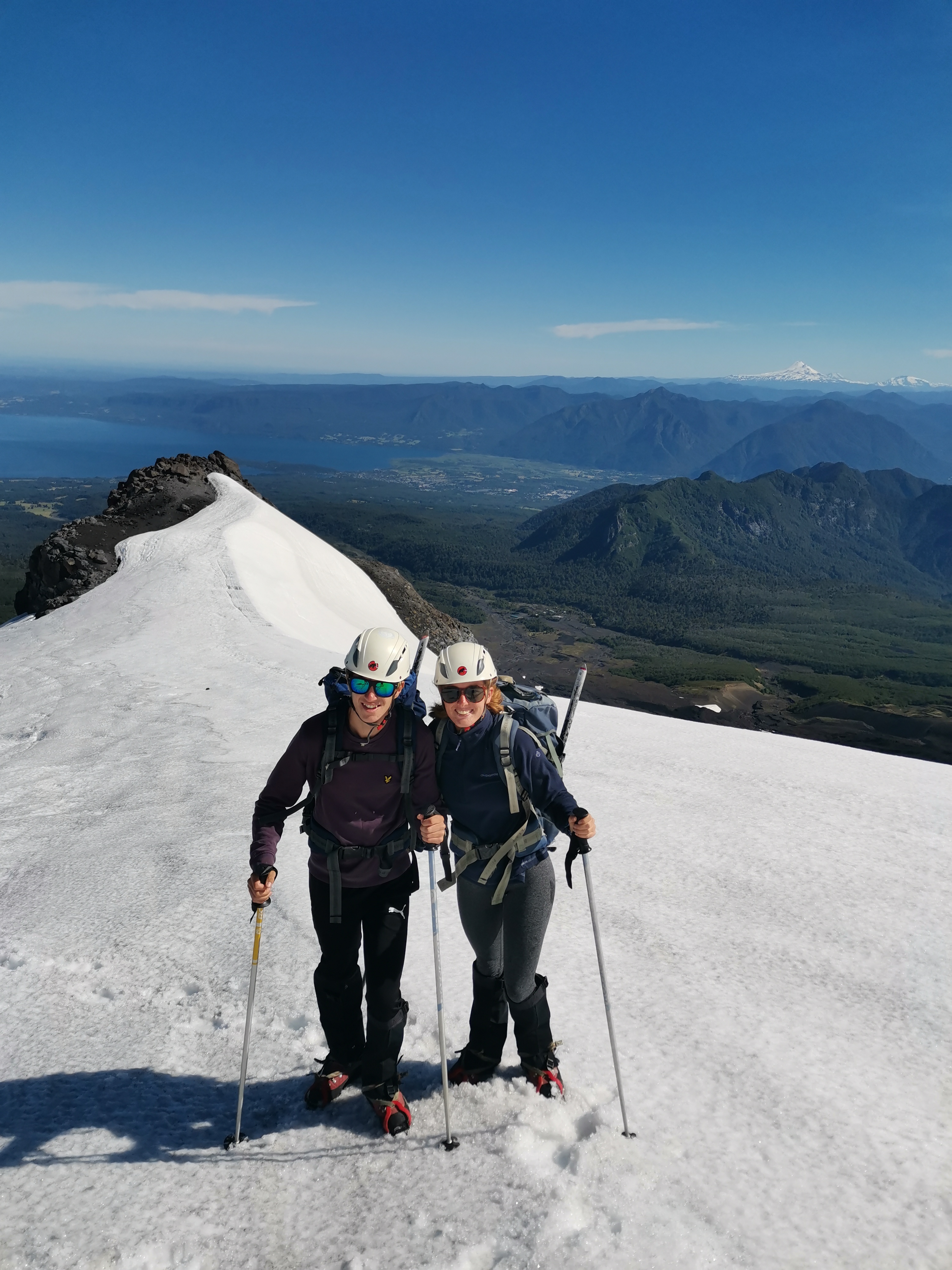
From the icy lookout at the top of the hike, where we stopped for lunch, the enchanting lake district was laid out like a map below. Numerous volcanoes peak out from the alpine forests to the south, and the deep blue lake and winding rivers lie to the north. Between them, the town of Pucon appears as a small speck on the shores of the lake. In the foreground, the sheer white slopes of the volcano drop off steeply down to the forest below. The long, sweaty hike would have been worth it for this view alone, but really the fun was just getting started.
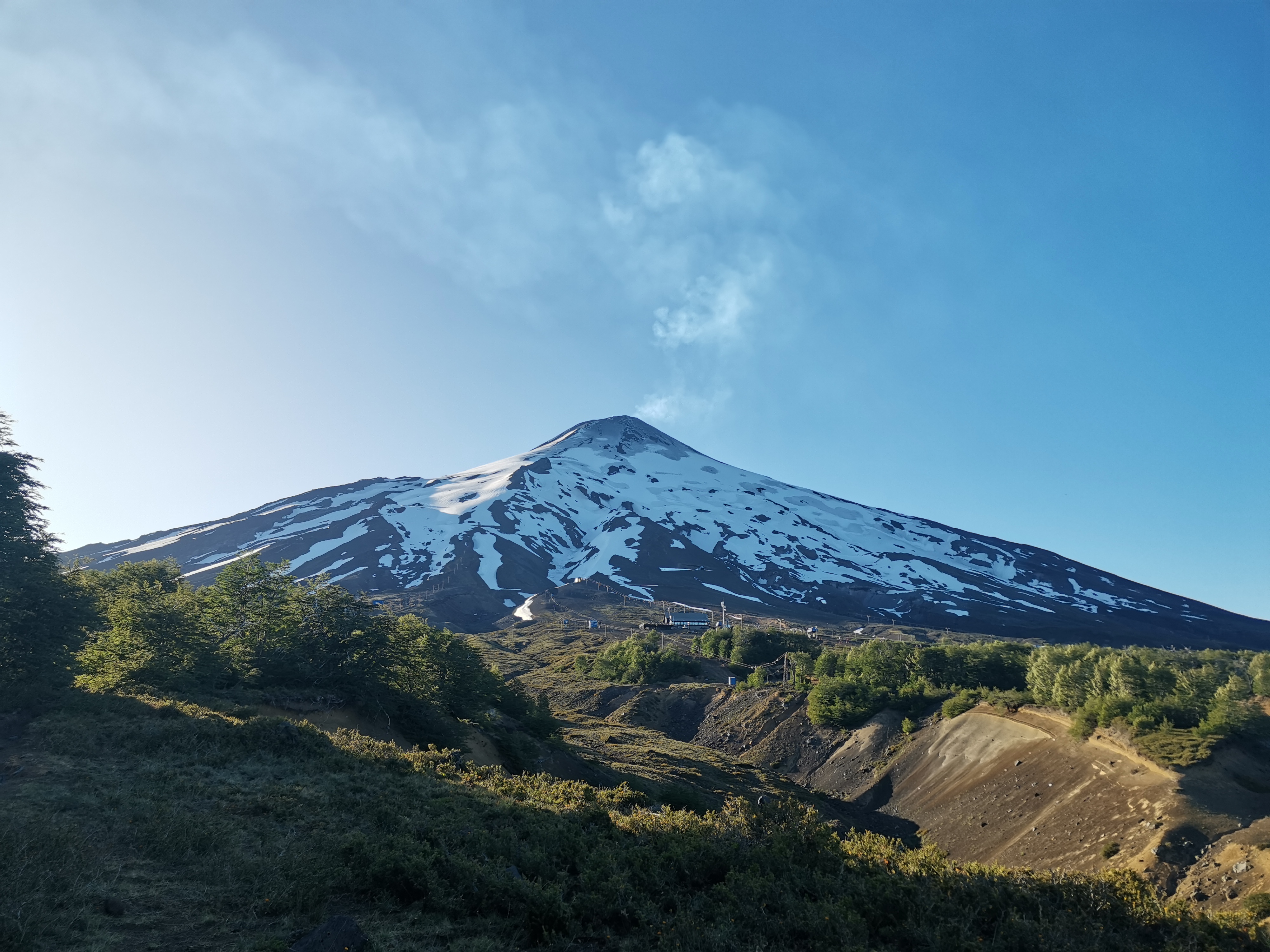
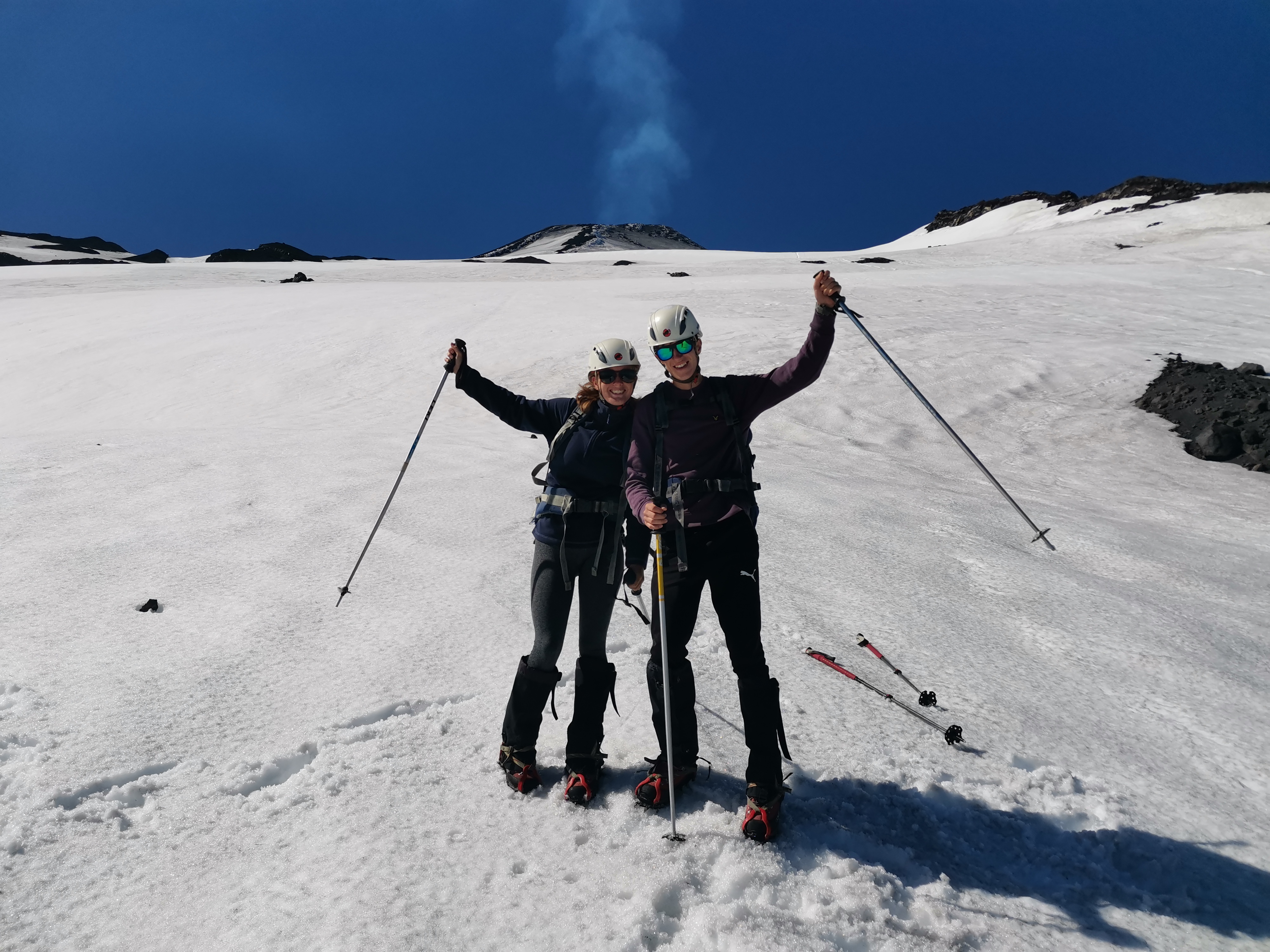


Cautiously tip-toeing back down the icy mountainside would be a painstaking task, but fortunately there is a better way. We were given plastic sledges, enabling us to slide back down. Although at first we gingerly shuffled through the snow, once we had mastered the technique and got to the steeper slopesThe volcano is actually a ski resort in the winter, when there is a lot more snow coverage. Although there is less snow in the summer, the slopes are still very steep and very fast., we were soon gaining more and more speed, hurtling down sat on top of our sledges. The panoramic views started dipped below the horizon, and the smoking summit grew smaller and further away as we flew through the snow and over the bumps, sending shards of ice spraying as we took the corners far too fast. It didn't take long to reach the bottom again, and we were back in Pucon after a tiring morning before we knew it, relaxing on the beach until the adrenaline had worn off.
Rivers, Waterfalls, and Countryside
Around Pucon, there is a wonderfull wilderness waiting to be explored, including a contless array of waterfalls. We only had time to explore a couple of the many cascading waterfalls on offer, including one of the closest and most impressive: Salto de Claro (‘clear falls’). This waterfall is a real treasure, tucked away down a woodland path. With a height of 90m, you need a minute to fully take in the enchanting scene from the viewing platformSalto de Claro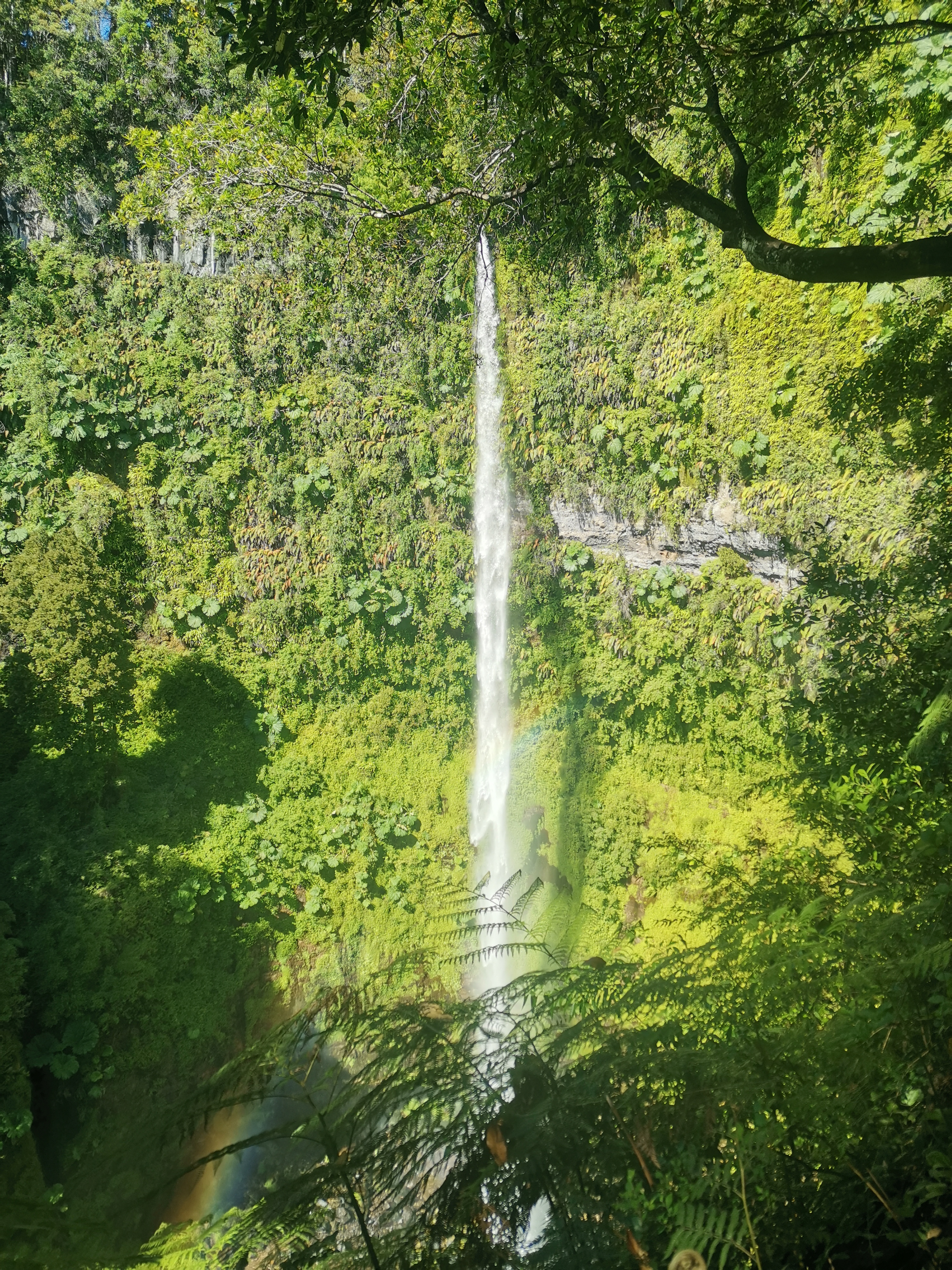 The most impressive thing about the Salto de Claro is its height. It is hard to see the top of it from the pool at its base, but the viewing platform is perfect for admiring the while scene from afar. near the top, before venturing down to the pool at the bottom. The narrow stream of water plummets over the concave cliff, which is coated in green mossy plants, and into a small clearing below. The experience of standing at its base is a special experience, as the sprey from the powerful cascade drifts into the spotlight of the midday sun. We ventured here on Christmas day, and had this perfect spot all to ourselves, but there is a small car park and some primitive infrastructure, so presumably the site is busier on most days.
The most impressive thing about the Salto de Claro is its height. It is hard to see the top of it from the pool at its base, but the viewing platform is perfect for admiring the while scene from afar. near the top, before venturing down to the pool at the bottom. The narrow stream of water plummets over the concave cliff, which is coated in green mossy plants, and into a small clearing below. The experience of standing at its base is a special experience, as the sprey from the powerful cascade drifts into the spotlight of the midday sun. We ventured here on Christmas day, and had this perfect spot all to ourselves, but there is a small car park and some primitive infrastructure, so presumably the site is busier on most days.
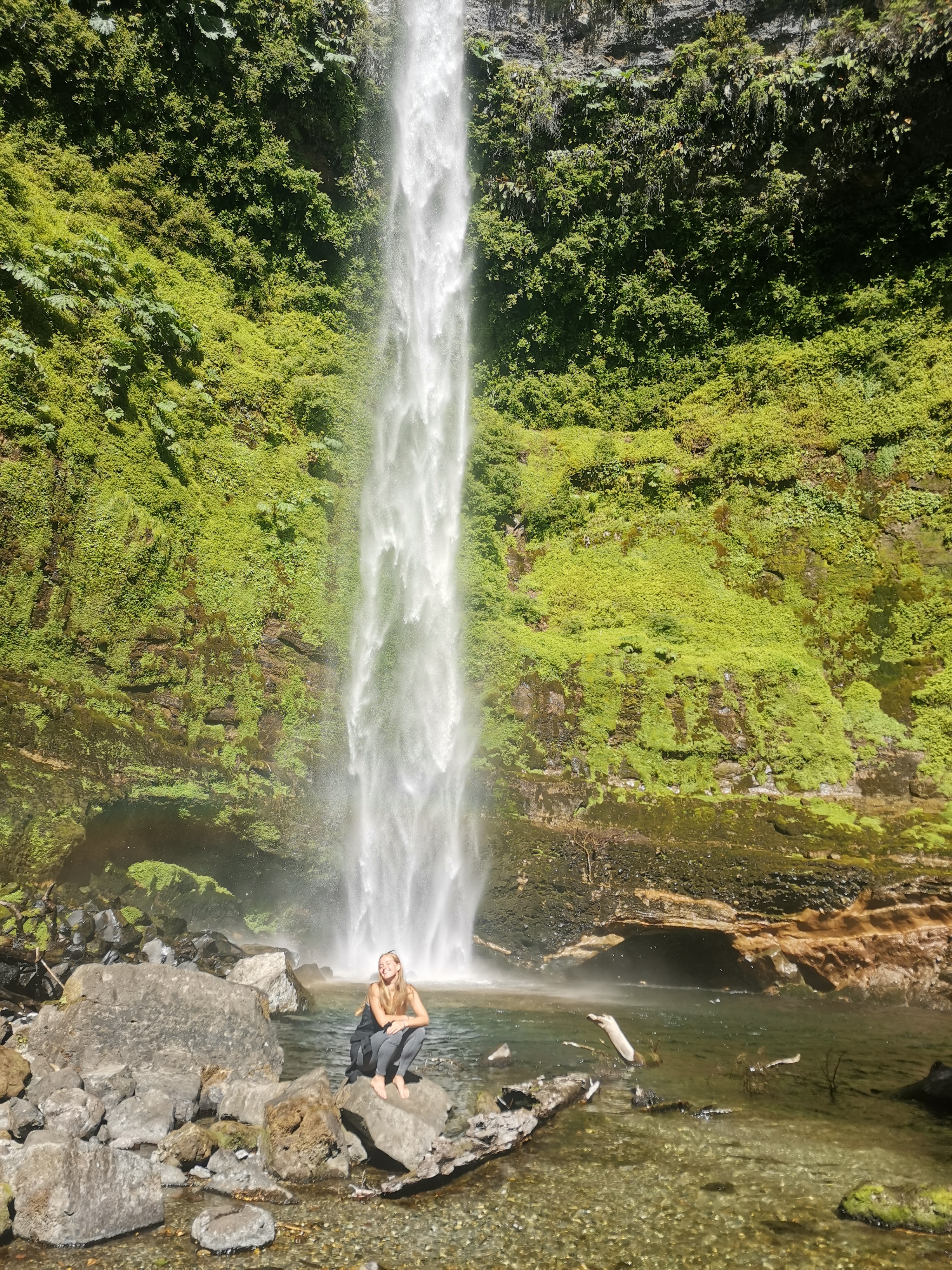
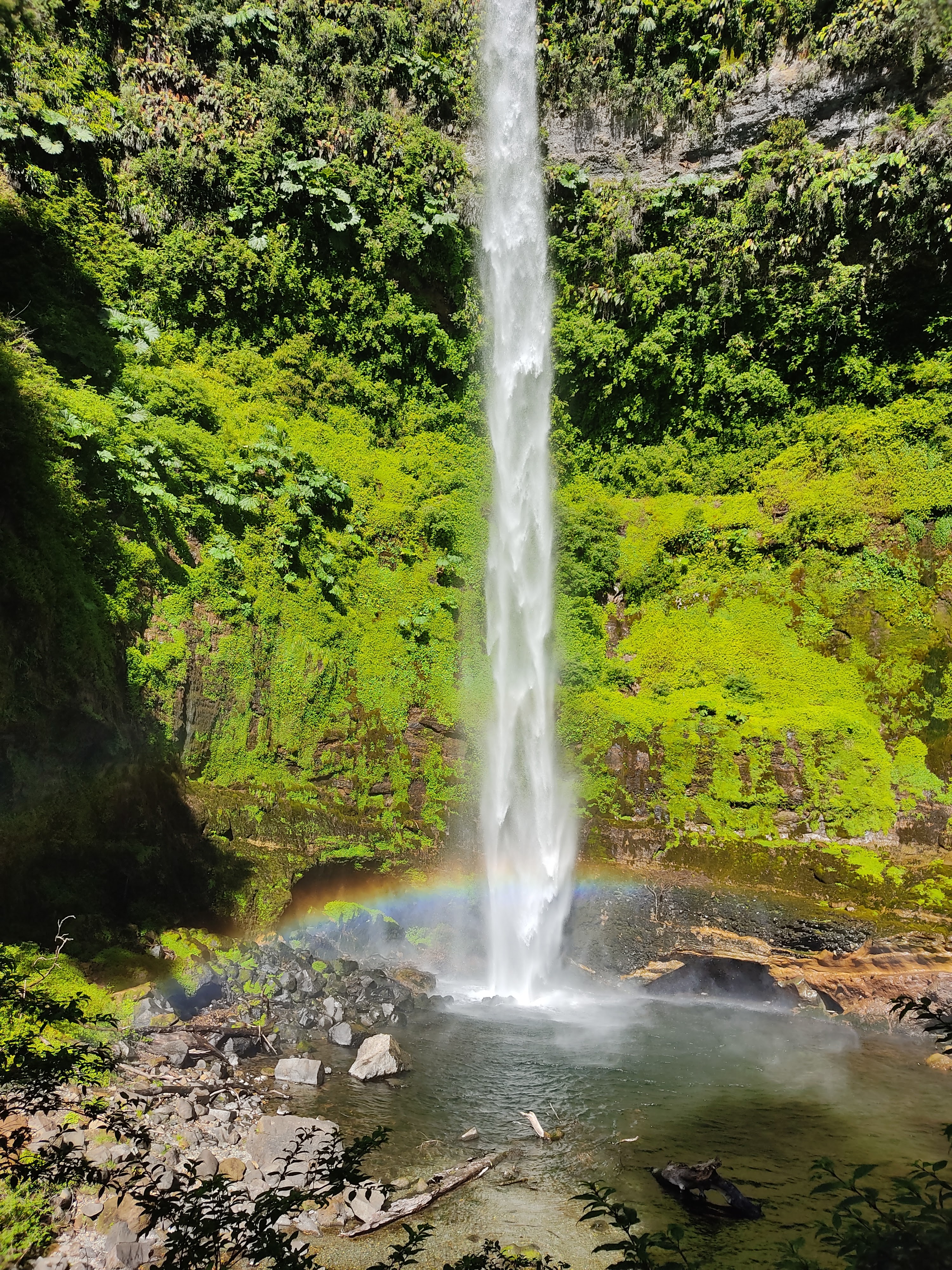
To explore the rich countryside around Pucon, we rented bikes and set off down the country roads winding through the pine forests. We passed small farmhouses rearing livestock, meadows of wildflowers, and curious horses watching us as we went, never escaping the view of the snow-capped volcano. We followed main road east (route 199), but took a detour down a smaller route (the S-919) that runs alongside the Rio Pucon/Minetue. Although this route is incredibly bumpy and hilly, it provides incredible views of the crystal clear river and surrounding farmland throughout. Despite its depth, the river is so clear that you can see right to the bottom, and after a hot day cycling in the sun, the subtle turqouise hue is incredibly inviting. However, the river originates from glacial mountain water, and is painfully cold. Even wading in the shallows made our feet numb in seconds, so we resorted to admiring the picturesque water from the banks.

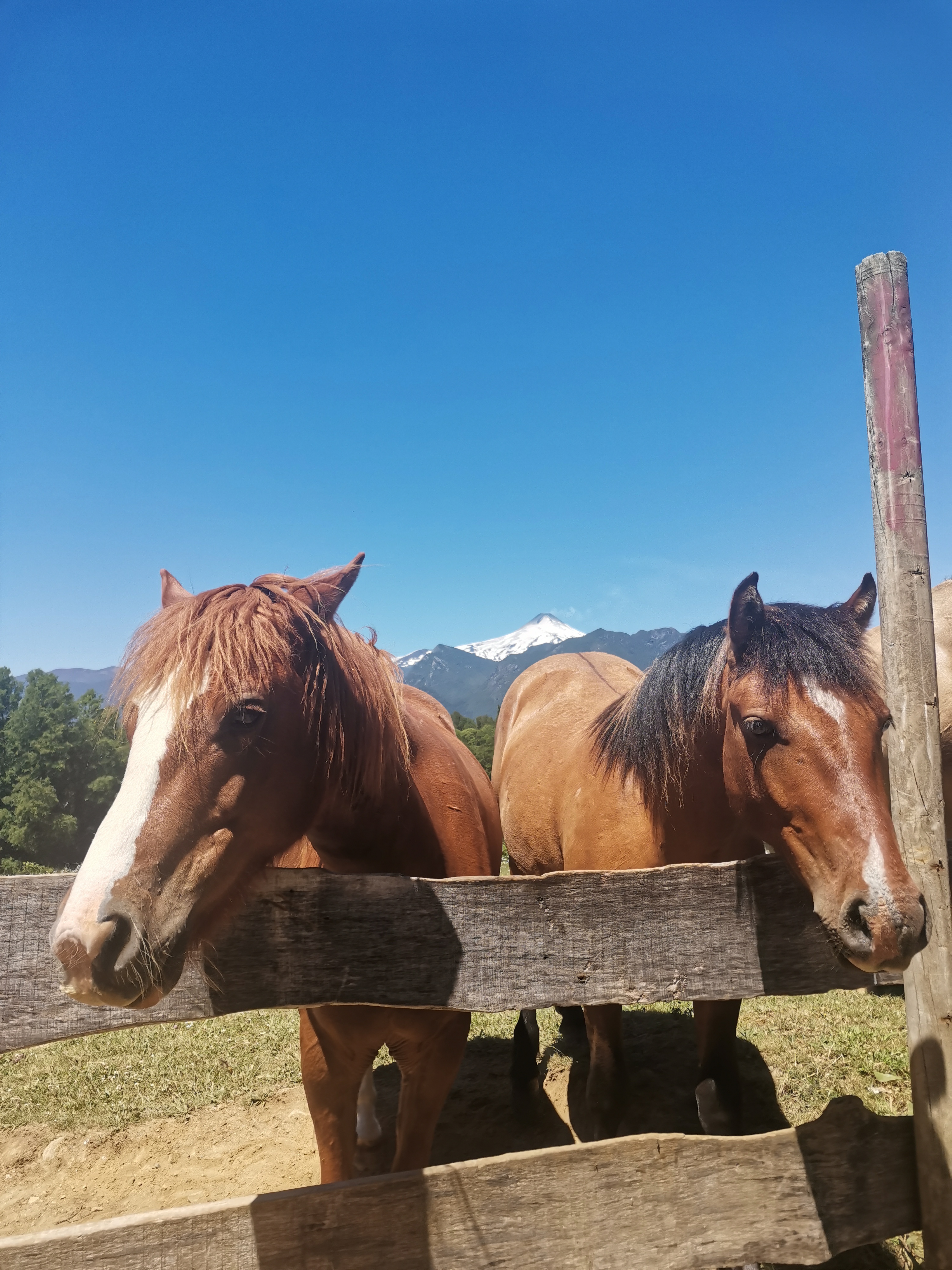
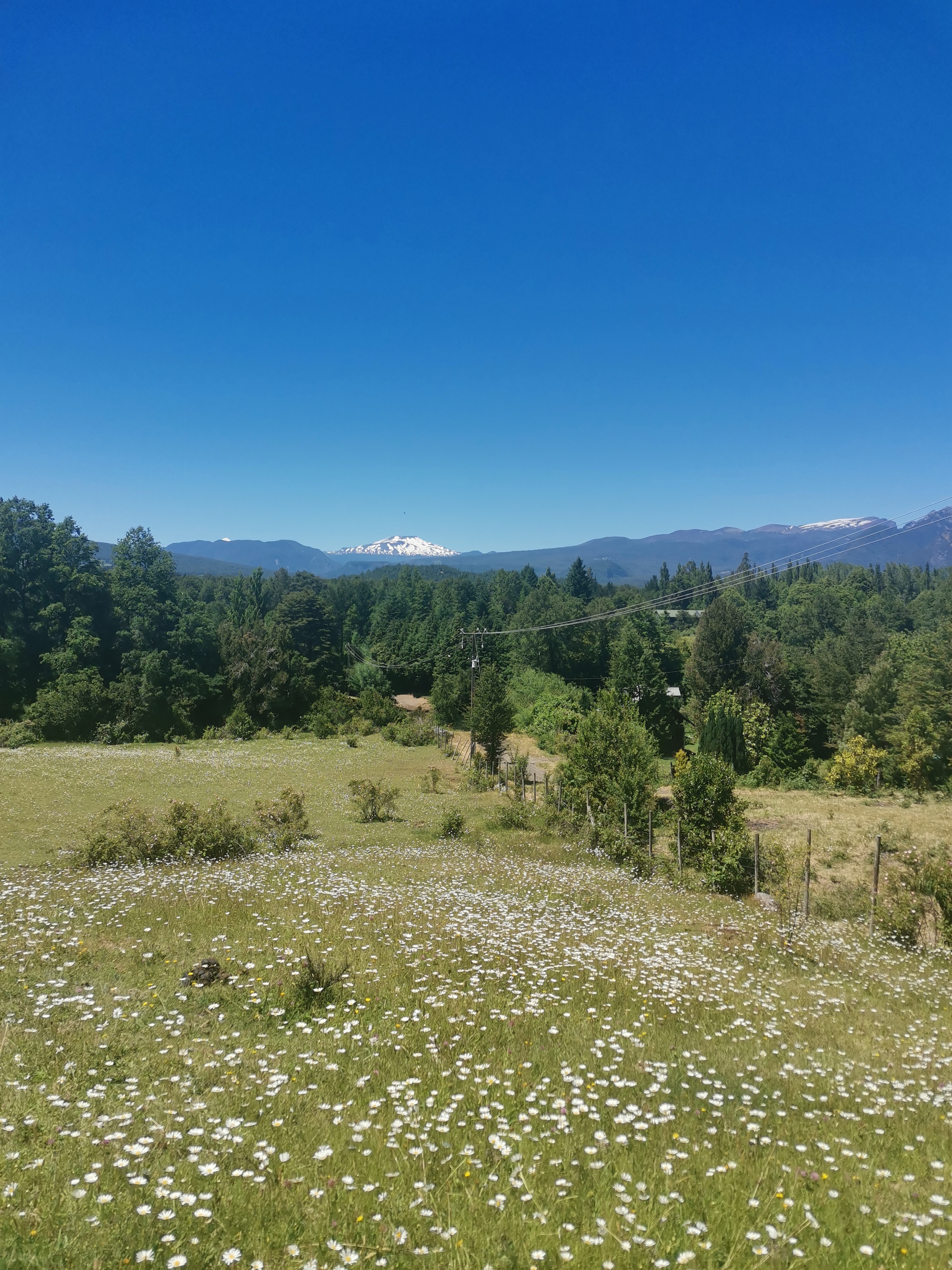

We stumbled across a part of the river known as Mirador de Peces, where a section has been converted to a fish farm. The clear water means you get a perfect view of all the fish, circling around in a slightly hypnotic fashion. There is a series of walkways running alongside the river too, providing a relaxing and peaceful stroll.
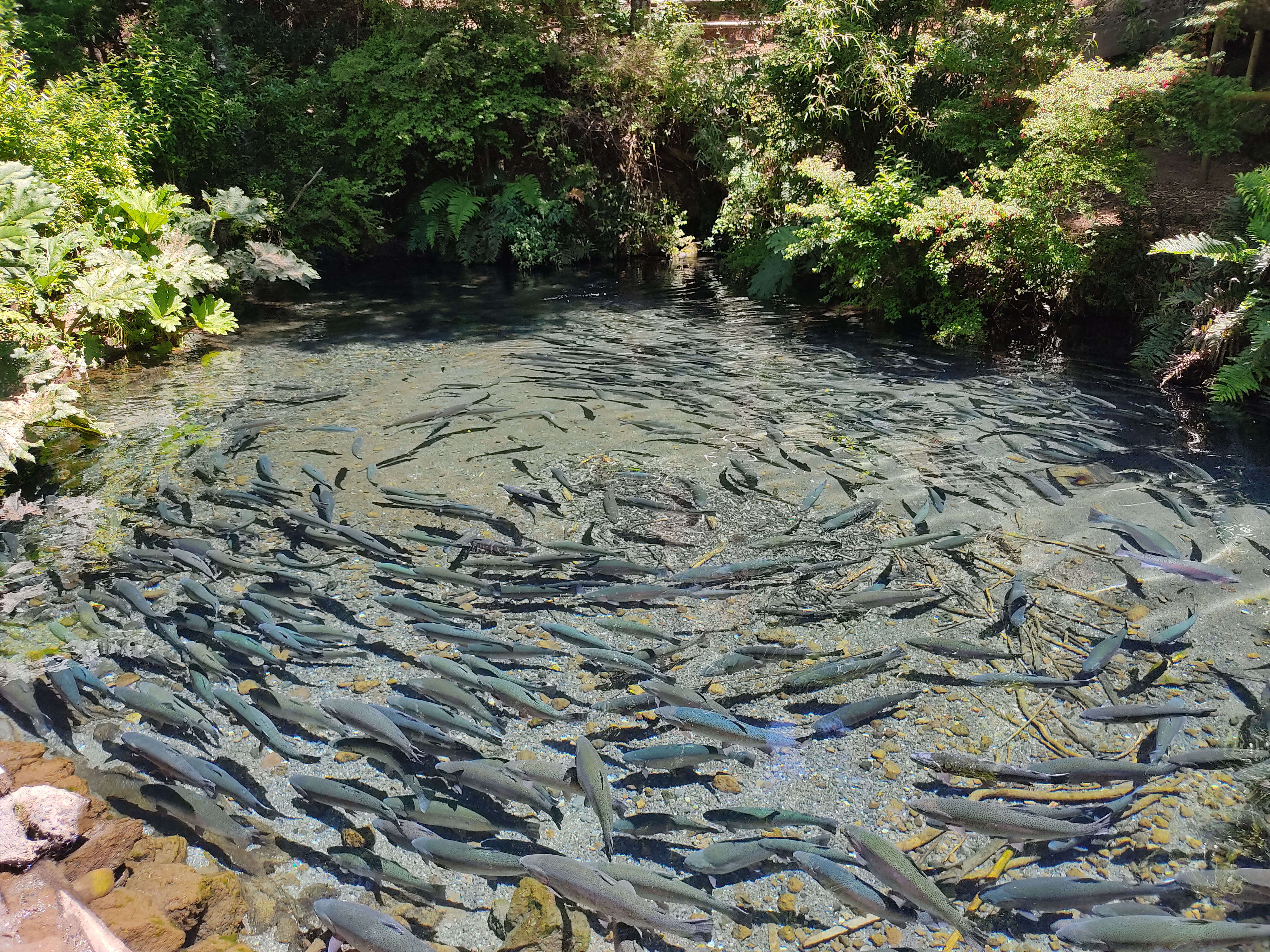

The most famous waterfalls near Pucon are the Ojos de Caburgua, which are located within a small park and campsite. They are named after the fact that the two parallel waterfalls look like crying eyes. Although you can't get as close as we would have liked to the waterfalls, and cannot swim in the inviting natural pools, it is still worth the 30 minutes bus rideLocal buses to Caburgua run from the small terminal opposite the JAC bus station in the town centre. Departures are regular, and stop off near the Ojos de Carbruga on the way. to admire this unique site. There are also a few boarwalks which take you through the thick green shrubs of the forest to different viewpoints over the river and waterfalls.
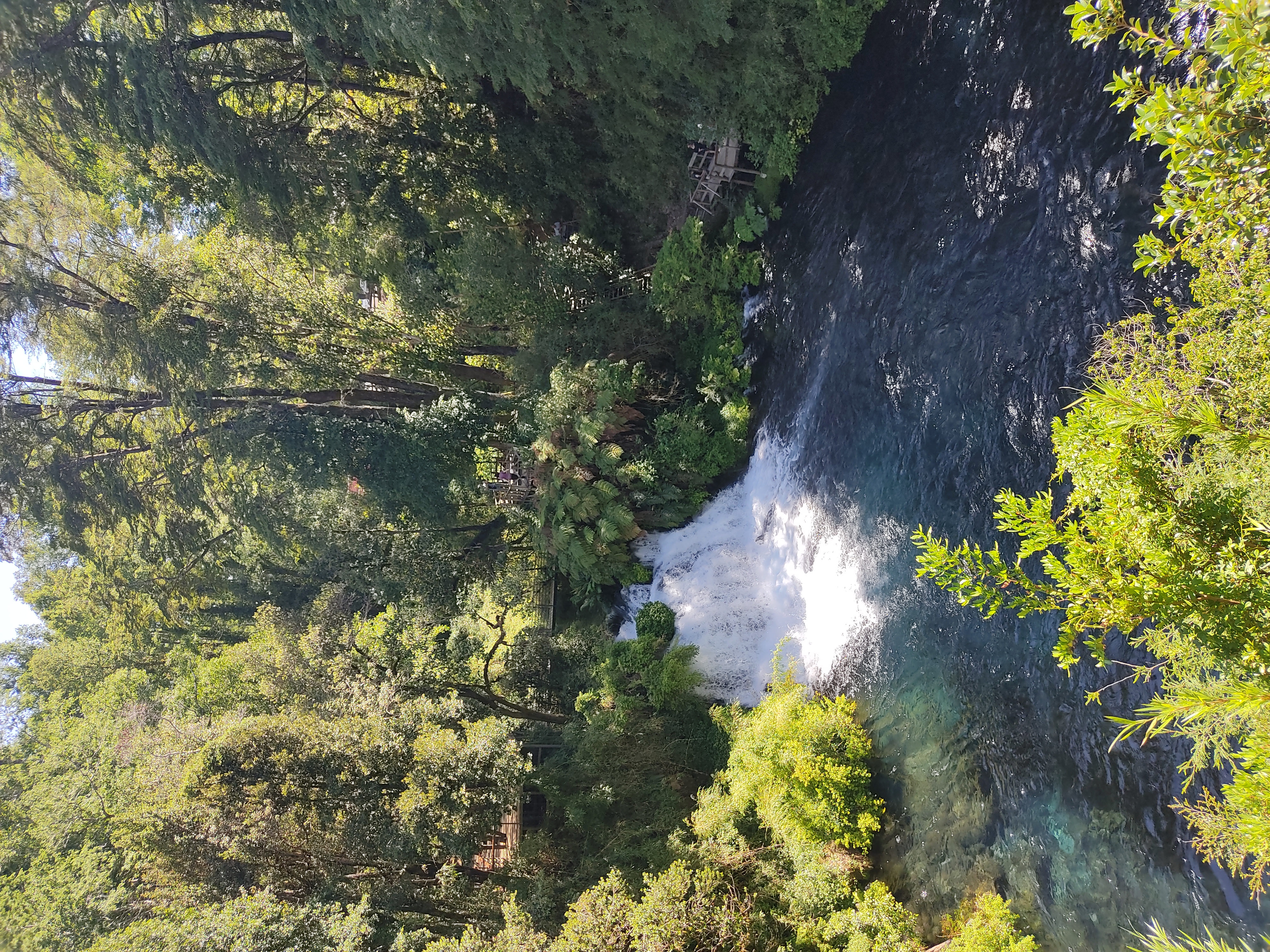
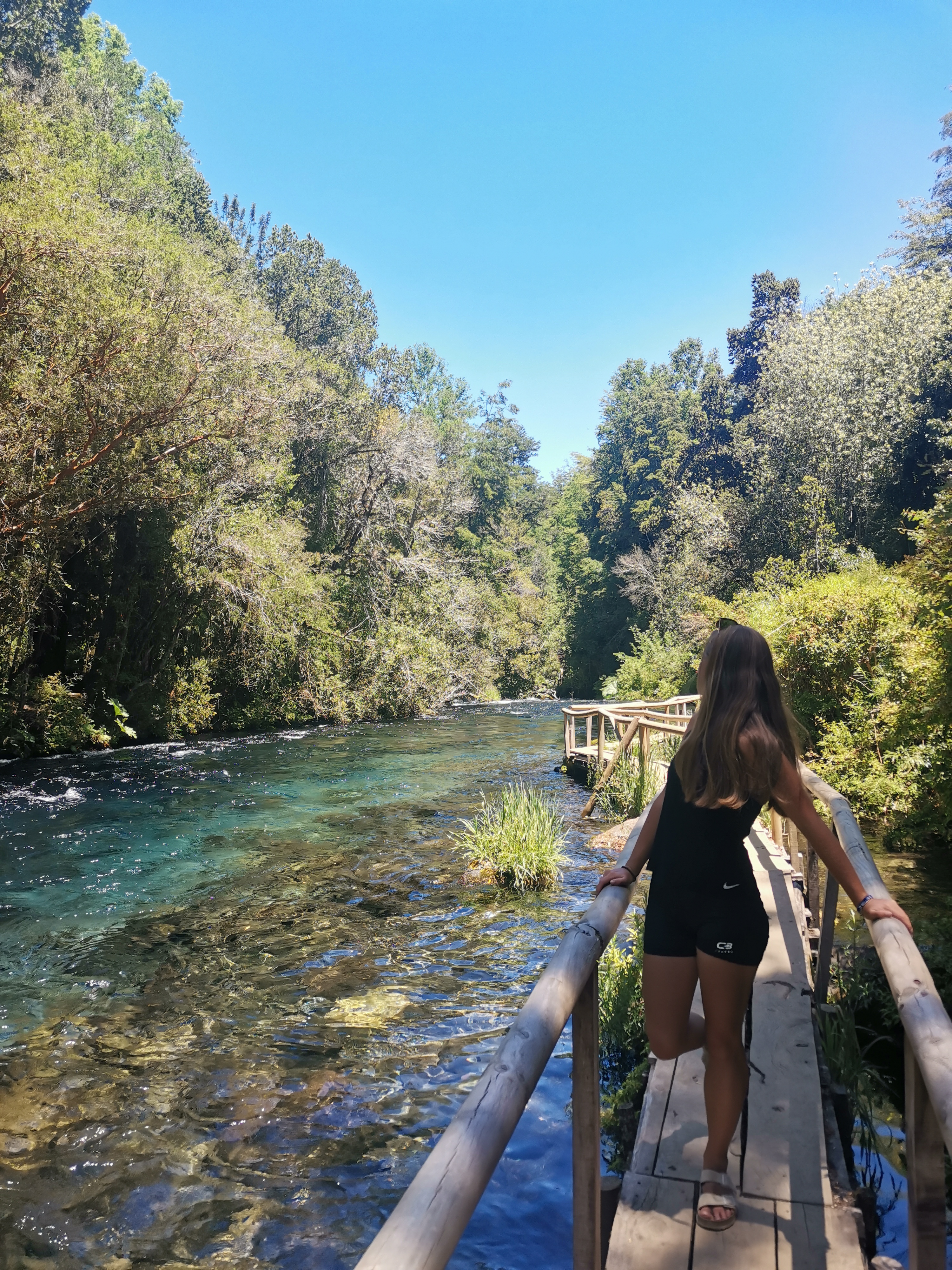
Confusingly, there are two places called Ojos de Caburgua on google maps, and there are two different entrances to the waterfalls, but they are not equal. The best entranceUnfortunately, this entrance was closed when we tried to visit with our bikes, so we only got to see the falls from their less-impressive angle. is the one to the west, which lies along a bumpy dirt road and is 3.5km walkThe west entrance is 16km from Pucon - reachable within 1hr by bike rented from the town. Just be prepared for a very bumpy ride! from the bus stop. Although the east entrance is much easier to get to, being right opposite the bus stop on the main road, this brings you to the wrong side of the river, so you can't see the iconic pair of waterfalls. You do still get a view of a smaller waterfall, and the circular pool filled with clear water, lined with ferns and shrubs, so either way the experience is great.
Puerto Varas
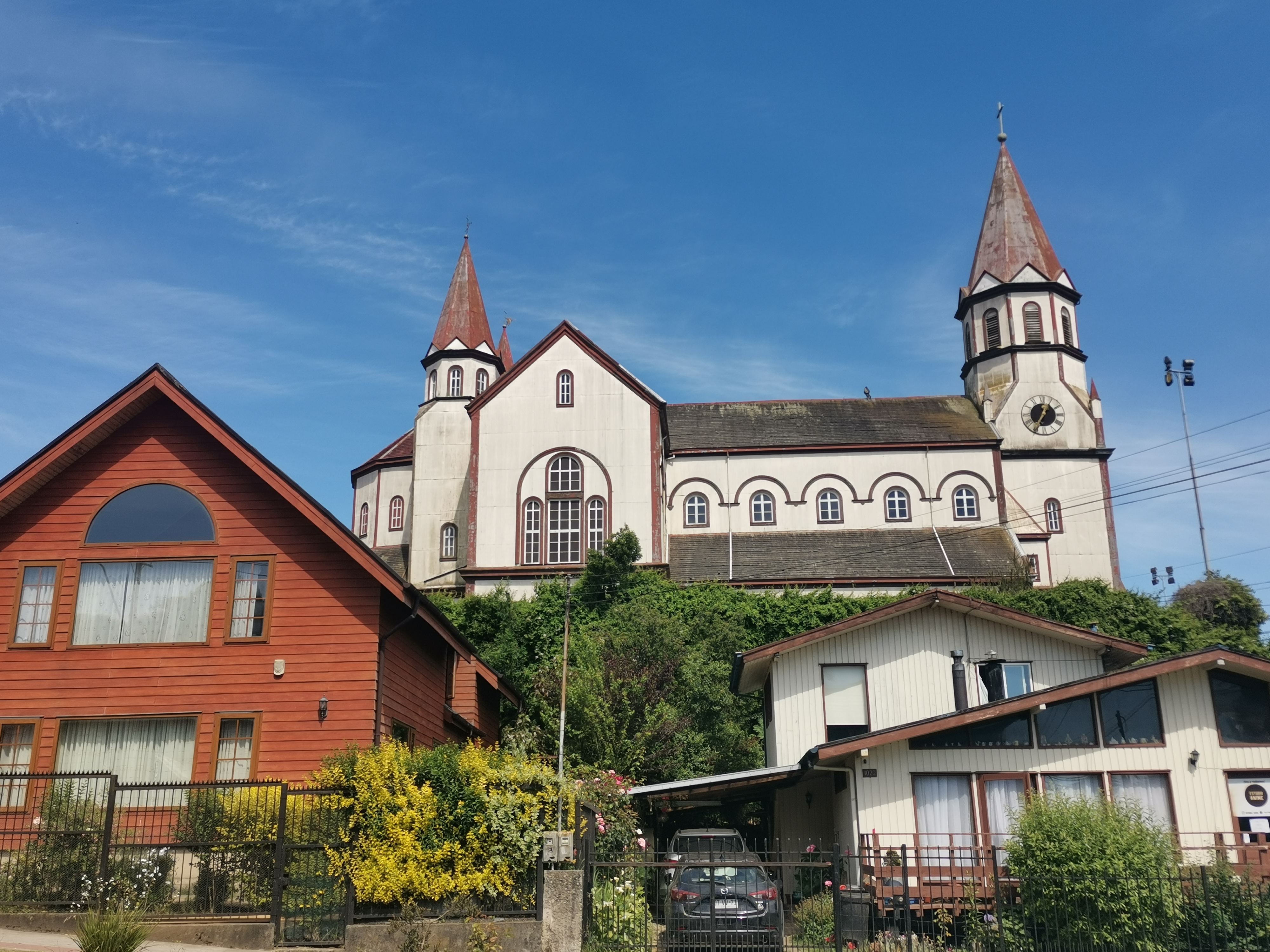
Puerto Varas
Superficially, Puerto Varas shares a lot of similarities with Pucon, as they are both lakeside towns, are surrounded by beautiful nature, and have a warm and welcoming feel. However, when you dive deeper, the two places are actually very different. Aside from being notably larger than Pucon, Puerto Varas has a lot of clear German influence in its architecture, with numerous timber-frame buildingsGerman architecture The German roots are evident in the structures and houses of Puerto Varas, making the town feel incredibly European. and even several German beer houses. Puerto Varas also has an unbeatable backdrop, with three snow-capped volcanoes on the horizon. Since it is a hilly town, there are some amazing vantage points where you can see all the elements of Puerto Varas and its surroundings that make it so increadible.
The German roots are evident in the structures and houses of Puerto Varas, making the town feel incredibly European. and even several German beer houses. Puerto Varas also has an unbeatable backdrop, with three snow-capped volcanoes on the horizon. Since it is a hilly town, there are some amazing vantage points where you can see all the elements of Puerto Varas and its surroundings that make it so increadible.
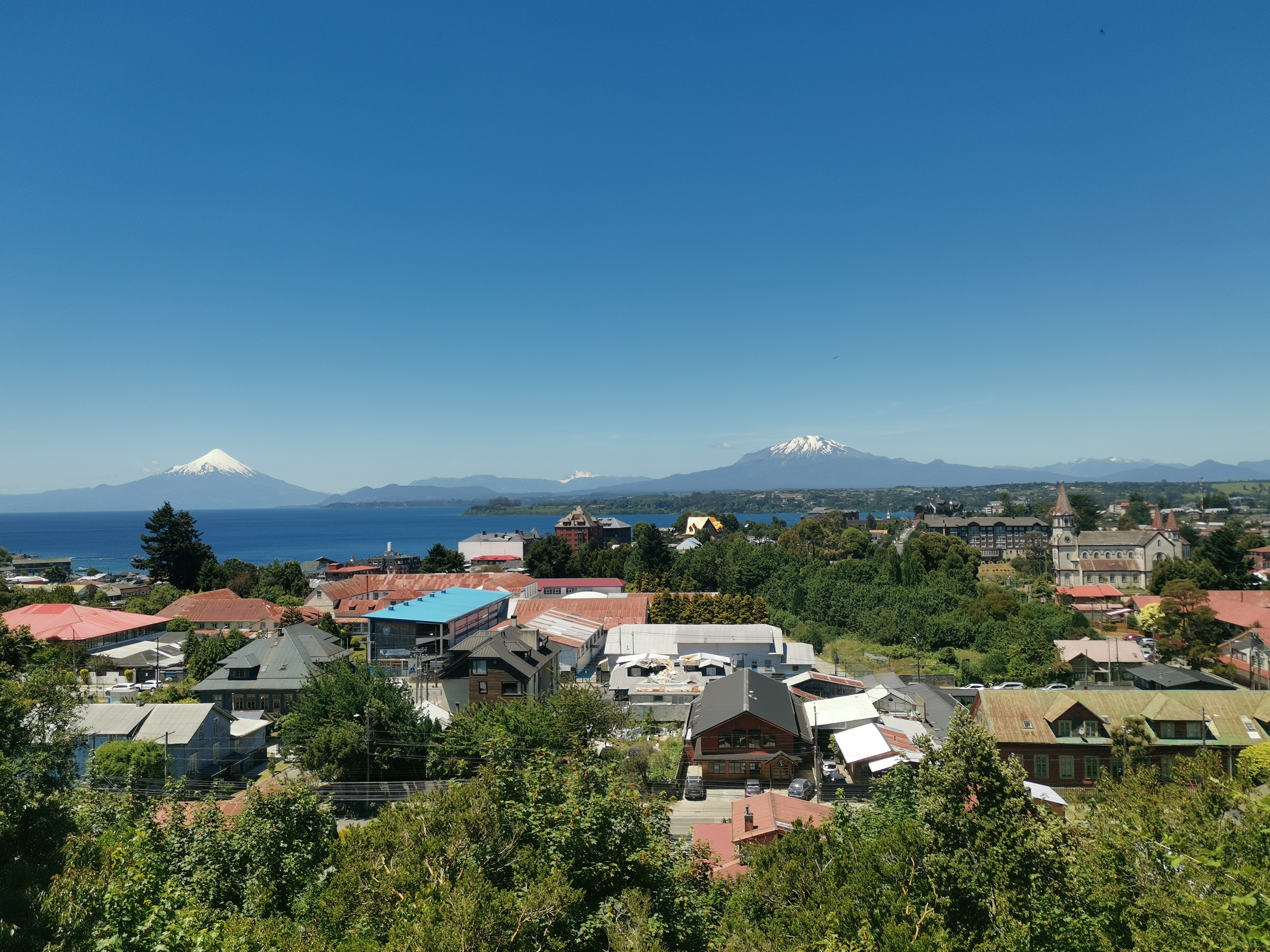
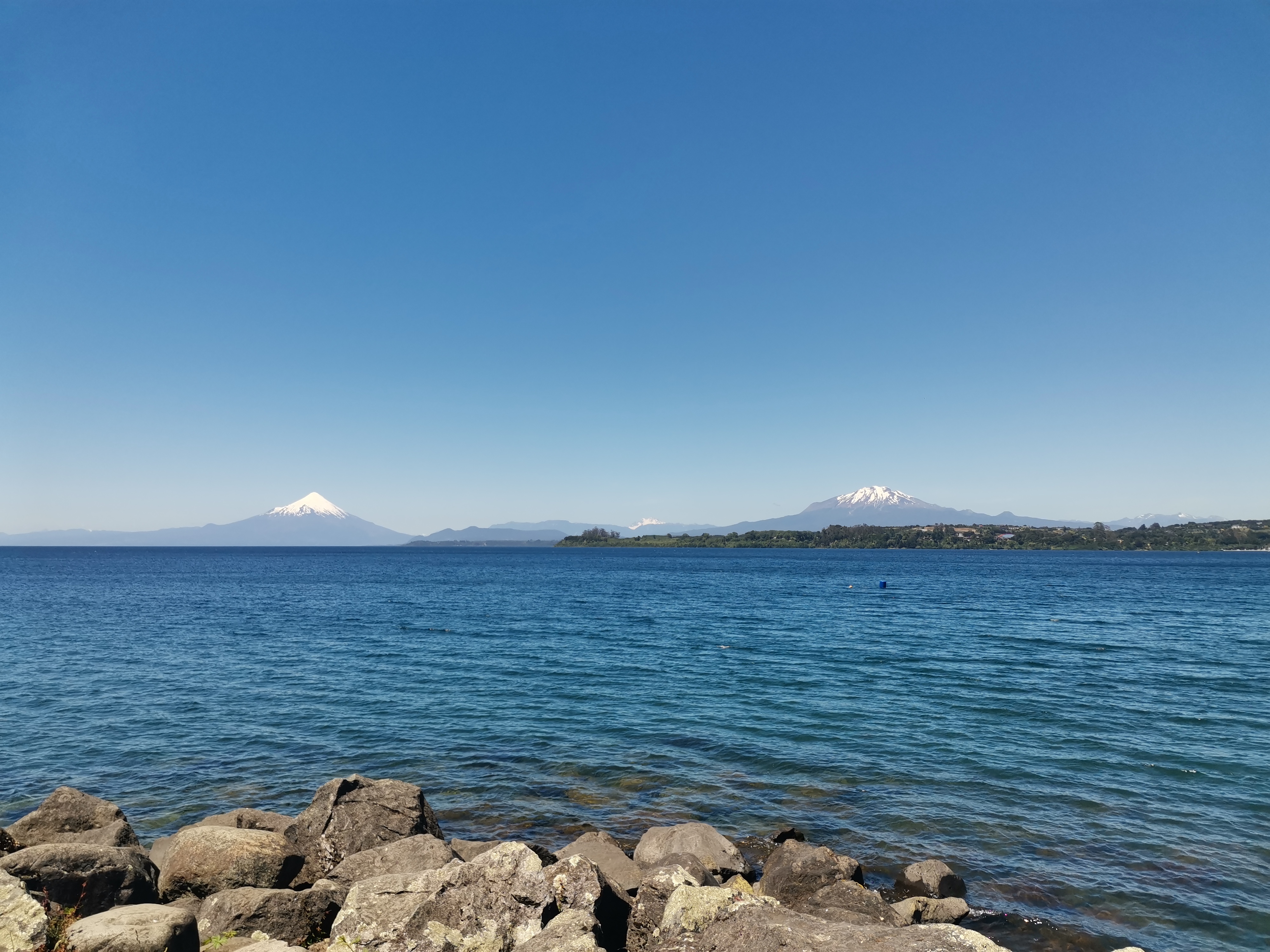
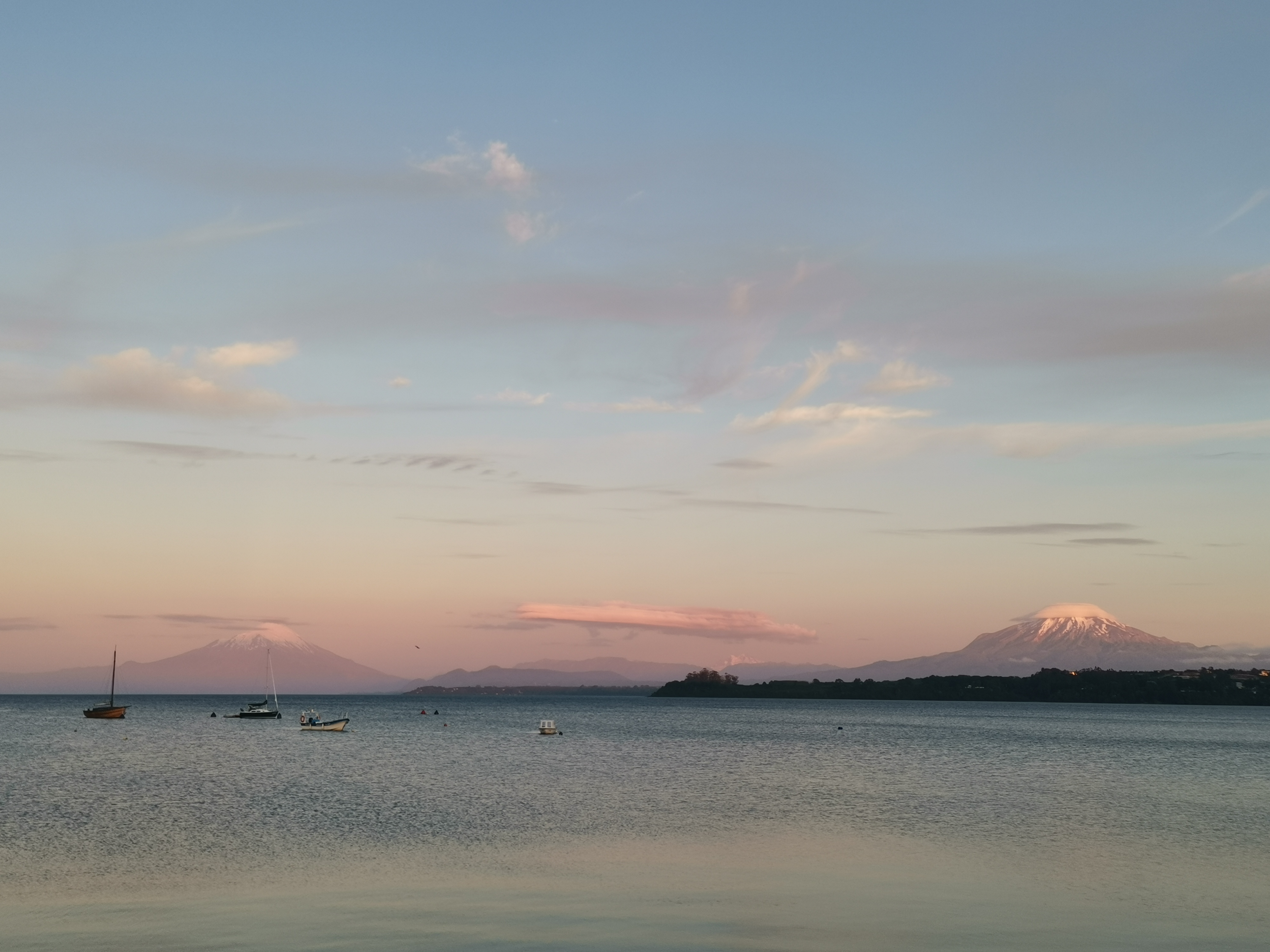
Although small, the beach is very popular with locals and families, who sunbathe on the volcanic sand or kayak in the shallow waters, and is the perfect place to relax. It is also close to several delicious ice-cream shops, as well as street vendors selling candied almonds, chocolate-covered strawberries, and popcorn.
Fruitillar and Llanquile
Although the German influences are clear in Puerto Varas, for an even more striking example, you can head to the nearby town of Fruitillar. Here, every single building and every street fits the aesthetic, with gothic architecture and wooden cabins everywhere you look. The town's structures are perfectly maintained, almost feeling like an open-air museum, with a long beach stretching parallel to the main road. The German heritage is not just present in the buildings; Fruitillar is famous for having several renowned German bakeries, serving a range of traditional snacks like küchen and apple strudel, many of which have slight South American variations.We must be too accustommed to the plethora of quality baking in Europe, because in general, we were not fans of the European pastries in South America - we had many disappointing croisants and pain au chocolates for breakfasts. Unfortunately, despite the glowing reviews, we also found the bakeries in Fruitillar fell short of our expectations. There is also a small courtyard full of food wagons just off of the beach, selling a whole range of refreshments, from smoothies to chips and pizzas, so Fruitillar has cuisine for everyone's tastes.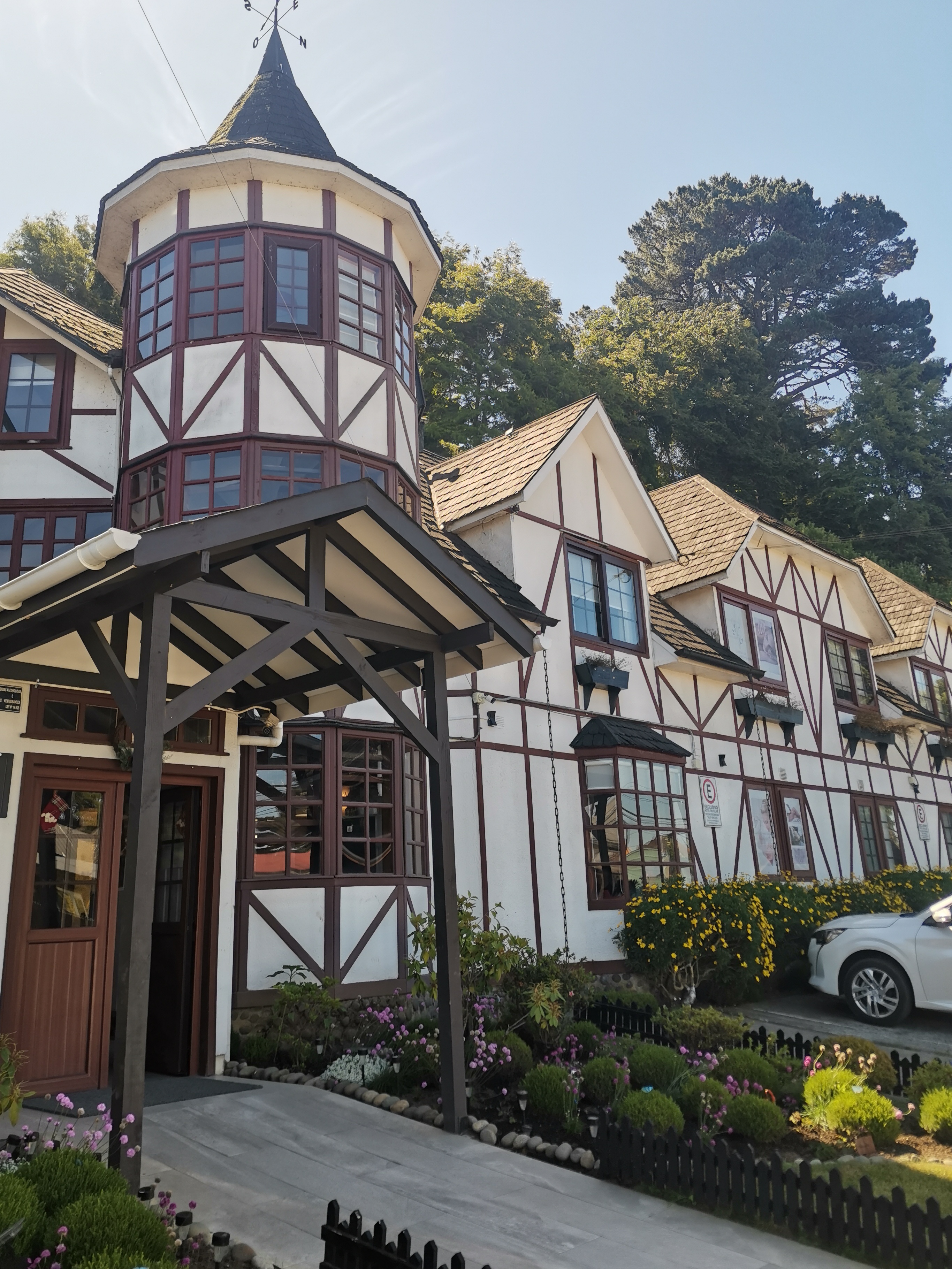
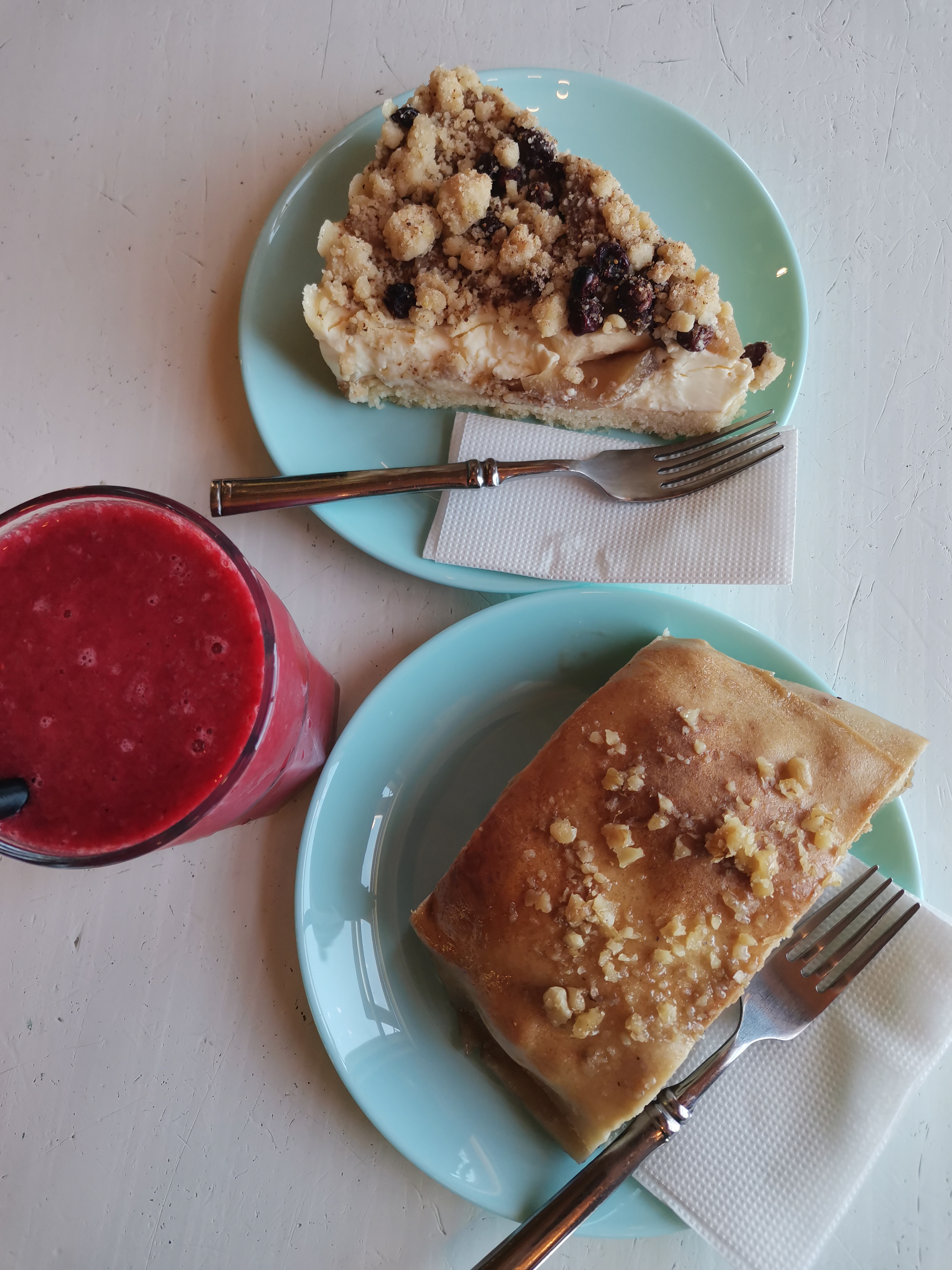
Although similar to the beach at Puerto Varas, Fruitillar provides a quieter and more relxaing experience and a different angle of the conical Osorno volcano. Halfway to Fruitillar, there is another small town called Llanquile, which again has quiet and calming stretches of beach along the lakeside. Together, these towns are a pleasant and easy day-trip from Puerto Varas, although they are very small so don't expect an action-packed day - it's best to take it slow and relax.

National Park Vicente Perez Rosales
Petrohue falls are a very popular tourist attraction, located 1.5hrs drive or bus ride from town. Although the waterfall is not as tall or impressive as those we saw from Pucon, it is located in the Vicente Perez Rosales national park, and its surroundings are unbelievably scenic. The wider area in general is full of picture-perfect views, and is home to the best spots to photograph the iconic Osorno volcano. Starting from the black volcanic sands of Playa EnsenadaAlthough the beach was peaceful and incredibly scenic, the relentless strong winds meant it was uncomfortably chilly even in the midday sun. There are also swarms of huge, biting flies in the park, so we didn't stay put here for too long., the park extends through an area of wild woodland, lakes, and rivers, providing a range of different views along the way.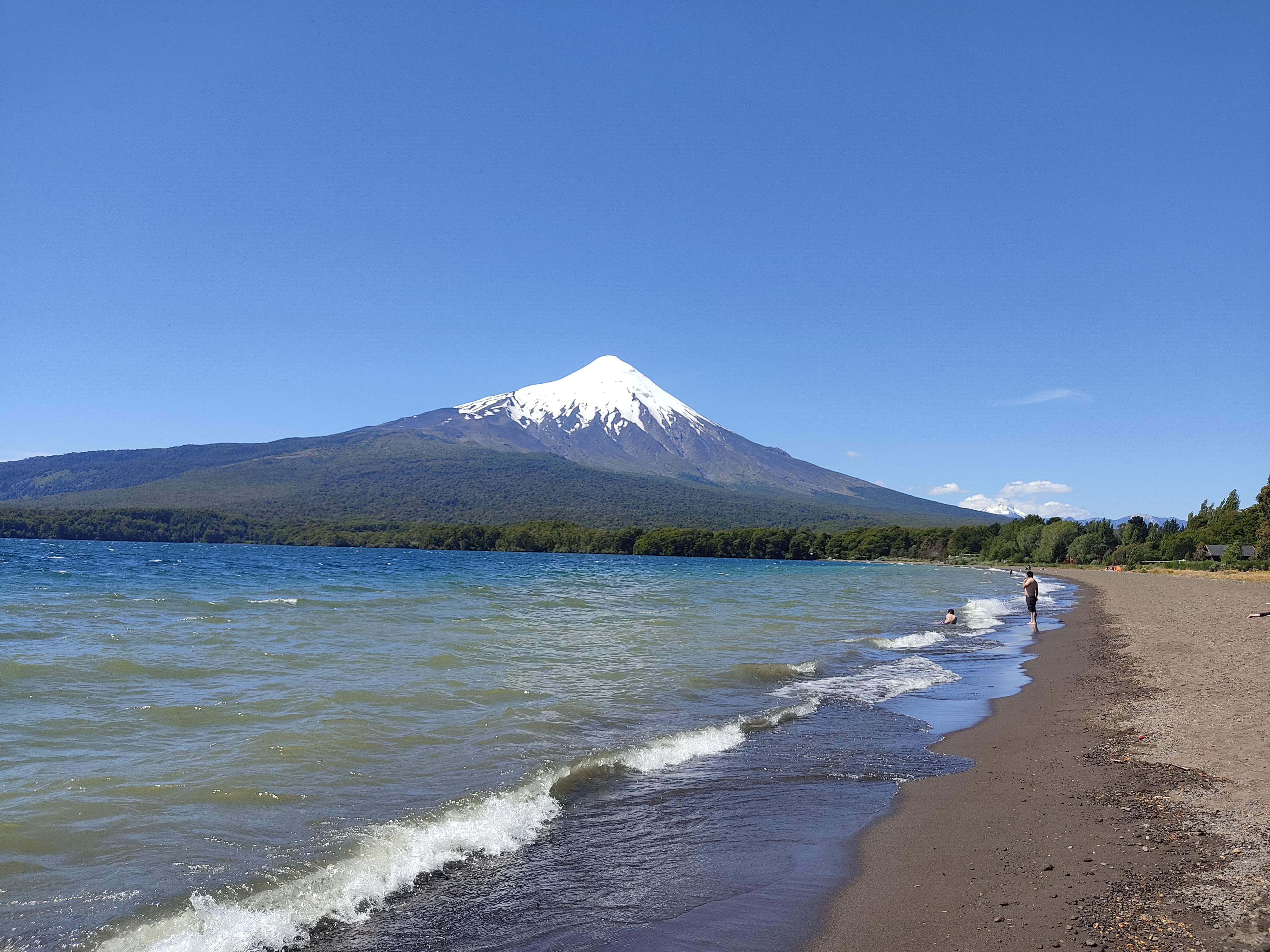
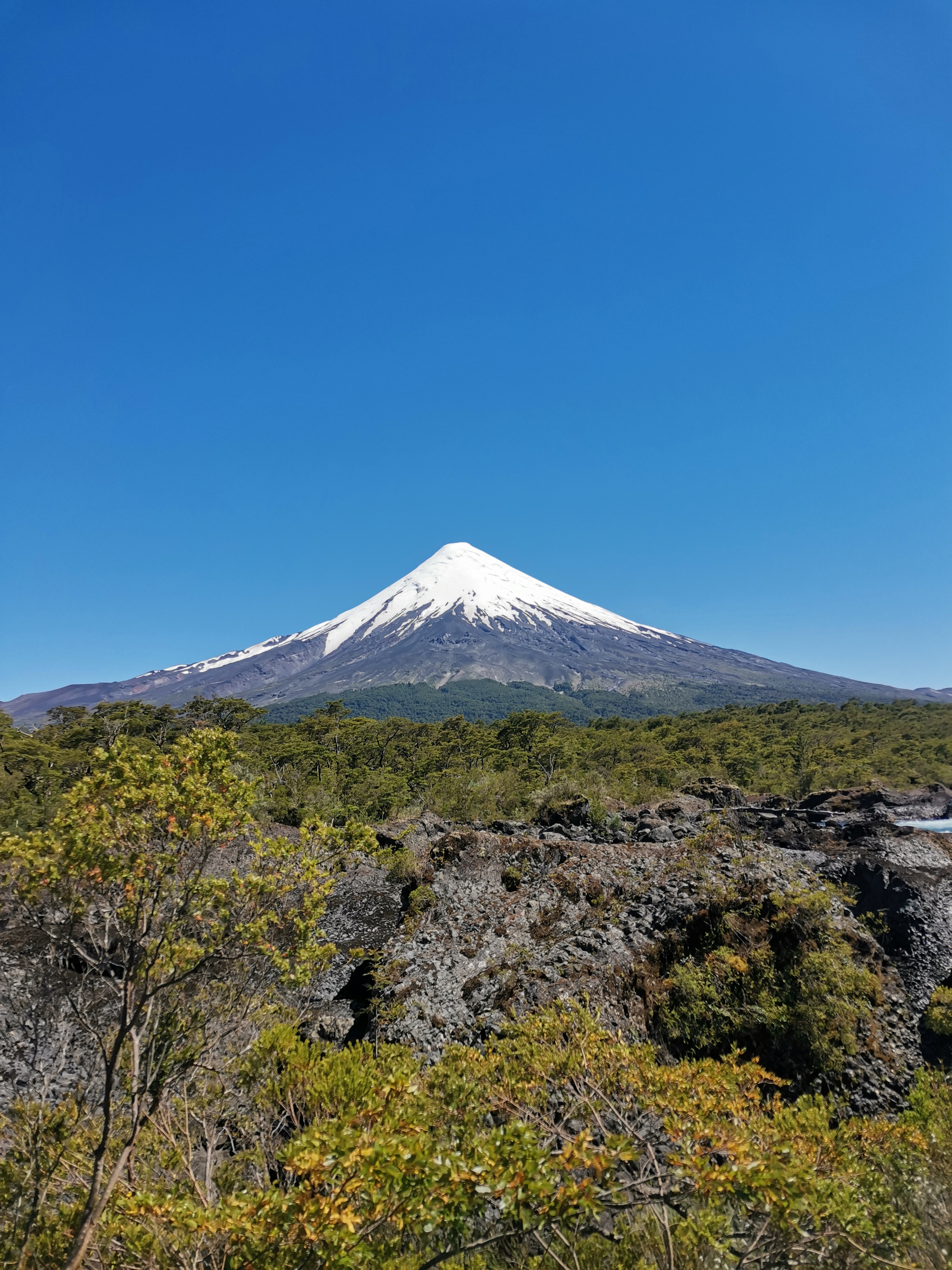
At the site of Petrohue falls, there is more to see than just the waterfall itself. There are a few short trails leading away from the crowds and into the woods, with tranquil spots overlooking the river, and rocky clearings where you can sit on the banks and fully appreciate the pristine natural surroundings. Further north along the main road, Lago Todos los SantosLago Todos los Santos
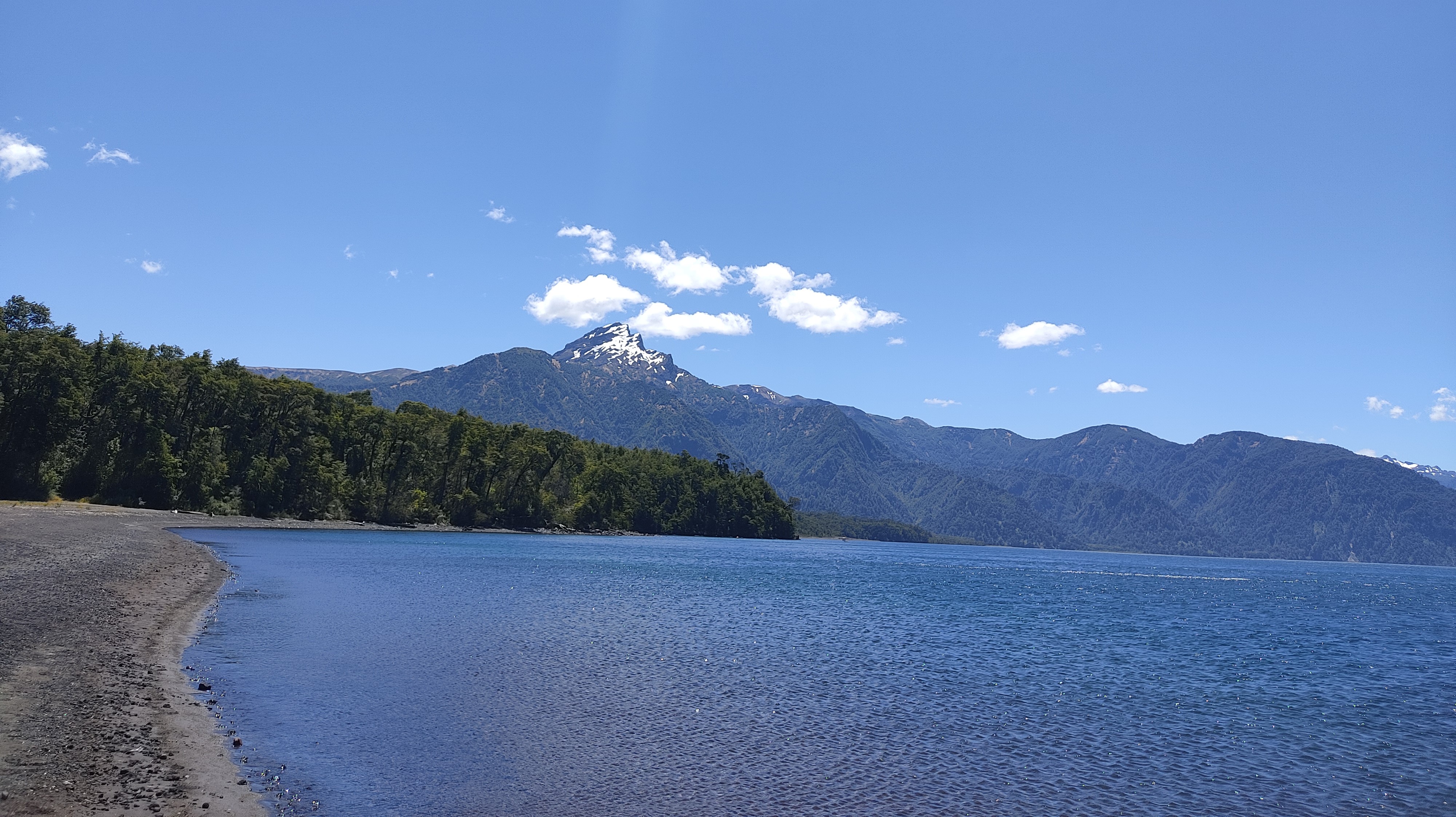 lies, which can be reached by the same bus that goes to the waterfalls. We walked the 6km to the lake to save money instead, and were rewarded with more incredible views over the turbulant river, which were arguably betterThe road to Lago Todos los Santos
lies, which can be reached by the same bus that goes to the waterfalls. We walked the 6km to the lake to save money instead, and were rewarded with more incredible views over the turbulant river, which were arguably betterThe road to Lago Todos los Santos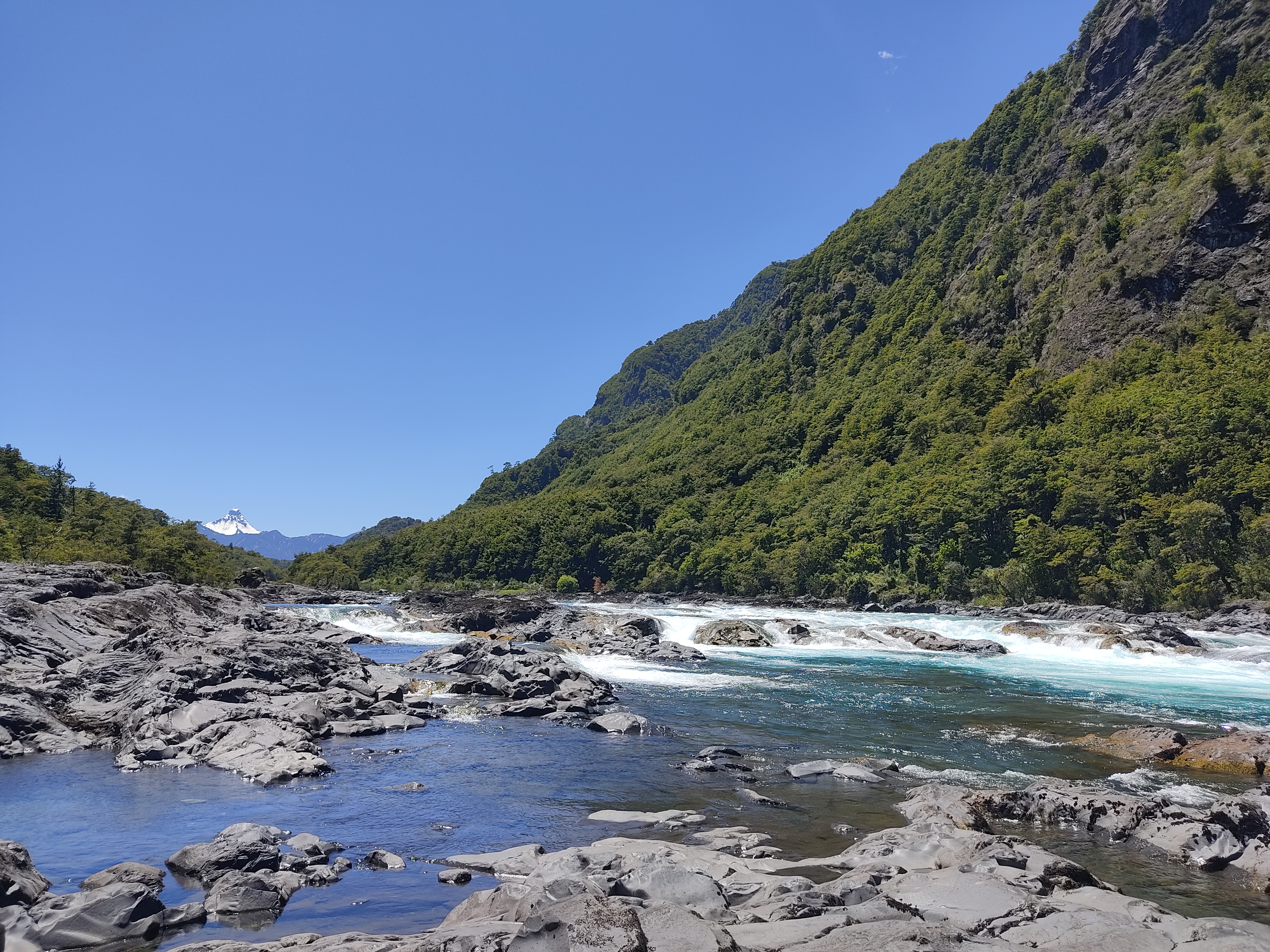 When we managed to dodge the swarms of flies, the walk through the trees was incredbly relaxing, with the occasional viewpoint overlooking the river. When we reached the lake at the end, we were disappointed to see that swimming was banned, and the only thing to do was take a short boat ride that was unfortunately out of our budget. than the lake itself.
When we managed to dodge the swarms of flies, the walk through the trees was incredbly relaxing, with the occasional viewpoint overlooking the river. When we reached the lake at the end, we were disappointed to see that swimming was banned, and the only thing to do was take a short boat ride that was unfortunately out of our budget. than the lake itself.


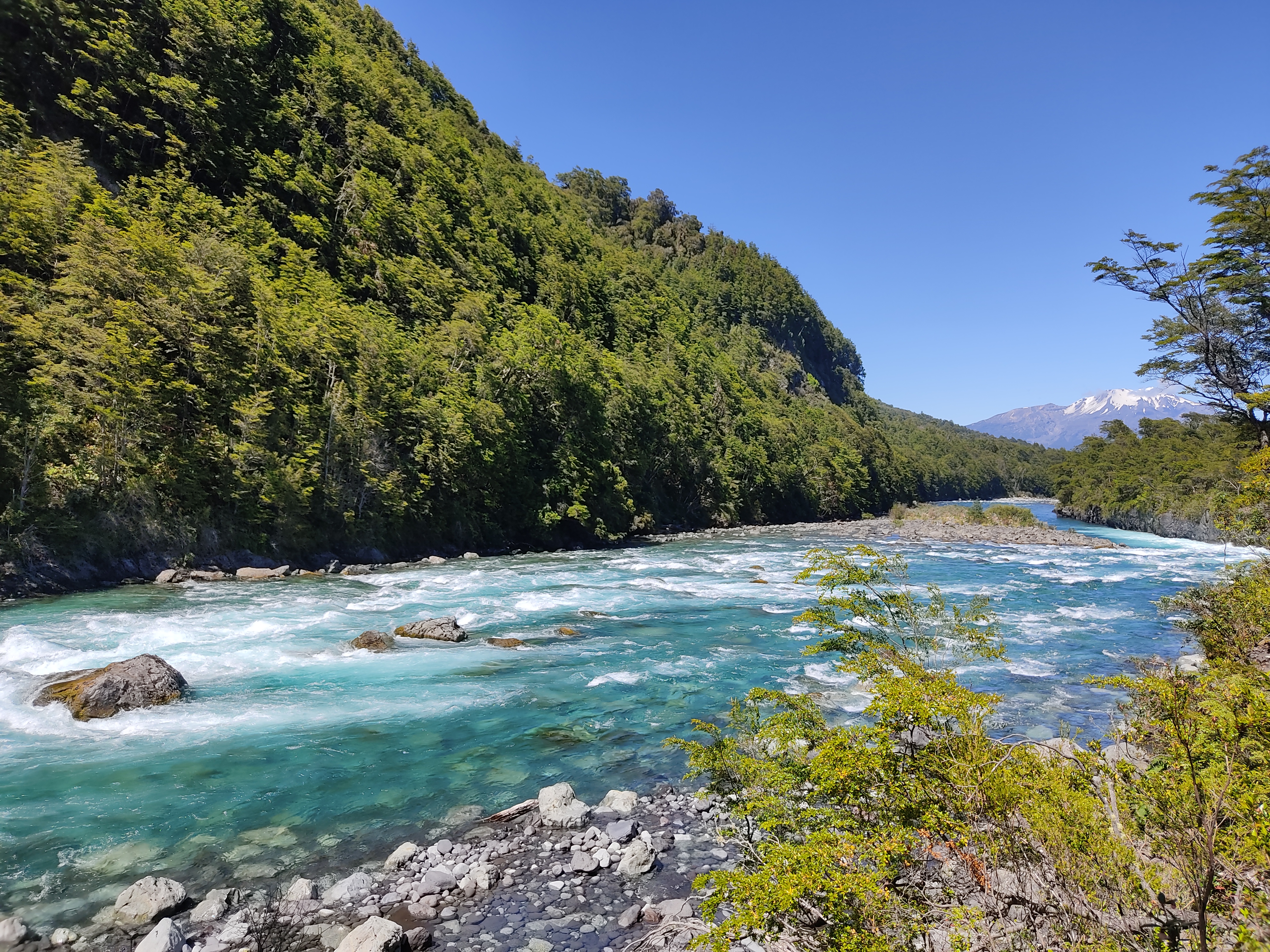
The waterfalls themselves are halfway along the main tree-lined road, and are more like a set of rapids than a tall waterfall. Nevertheless, the view over the foamy blue water and barren rocks to volcano Osorno in the background are truly spectacular, and crowds often gather to see this unique view of the Chilean landscspe. There is a small network of high walkways, which you can explore if you manage to tear your eyes away from the impressive sight of Osorno. From the vantage pointsPetrohue falls
 Although small and narrow, the falls have a captivating charm to them. The colours, location, and backdrop all complement each other perfectly., you can see the clear but deceptively-deep river as it eases its way gracefully through the rocky valley between the trees. From the bright colours of the river and the forest to the surrounding ecosystem, it is easy to see why so many people love this spot.
Although small and narrow, the falls have a captivating charm to them. The colours, location, and backdrop all complement each other perfectly., you can see the clear but deceptively-deep river as it eases its way gracefully through the rocky valley between the trees. From the bright colours of the river and the forest to the surrounding ecosystem, it is easy to see why so many people love this spot. 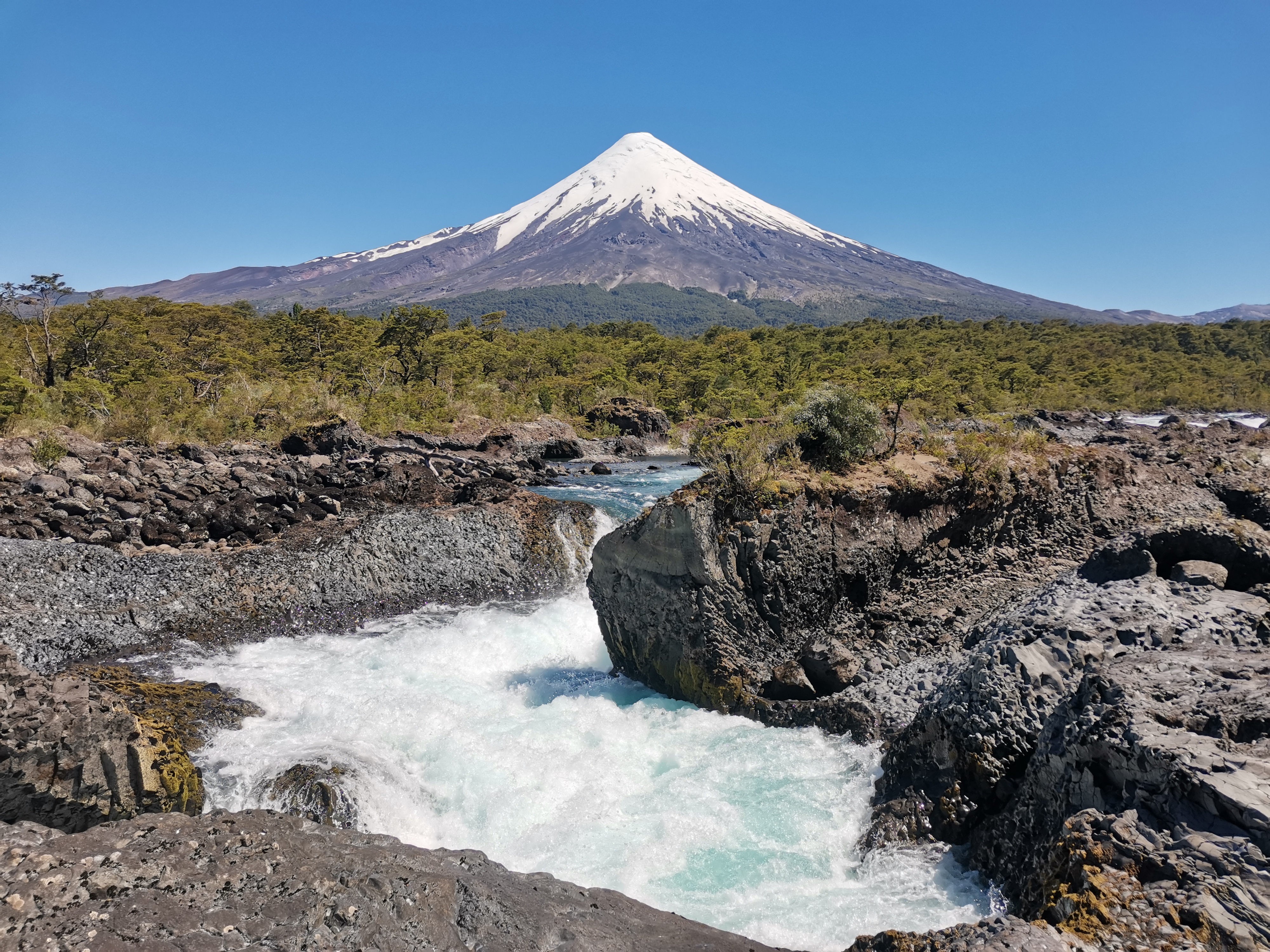
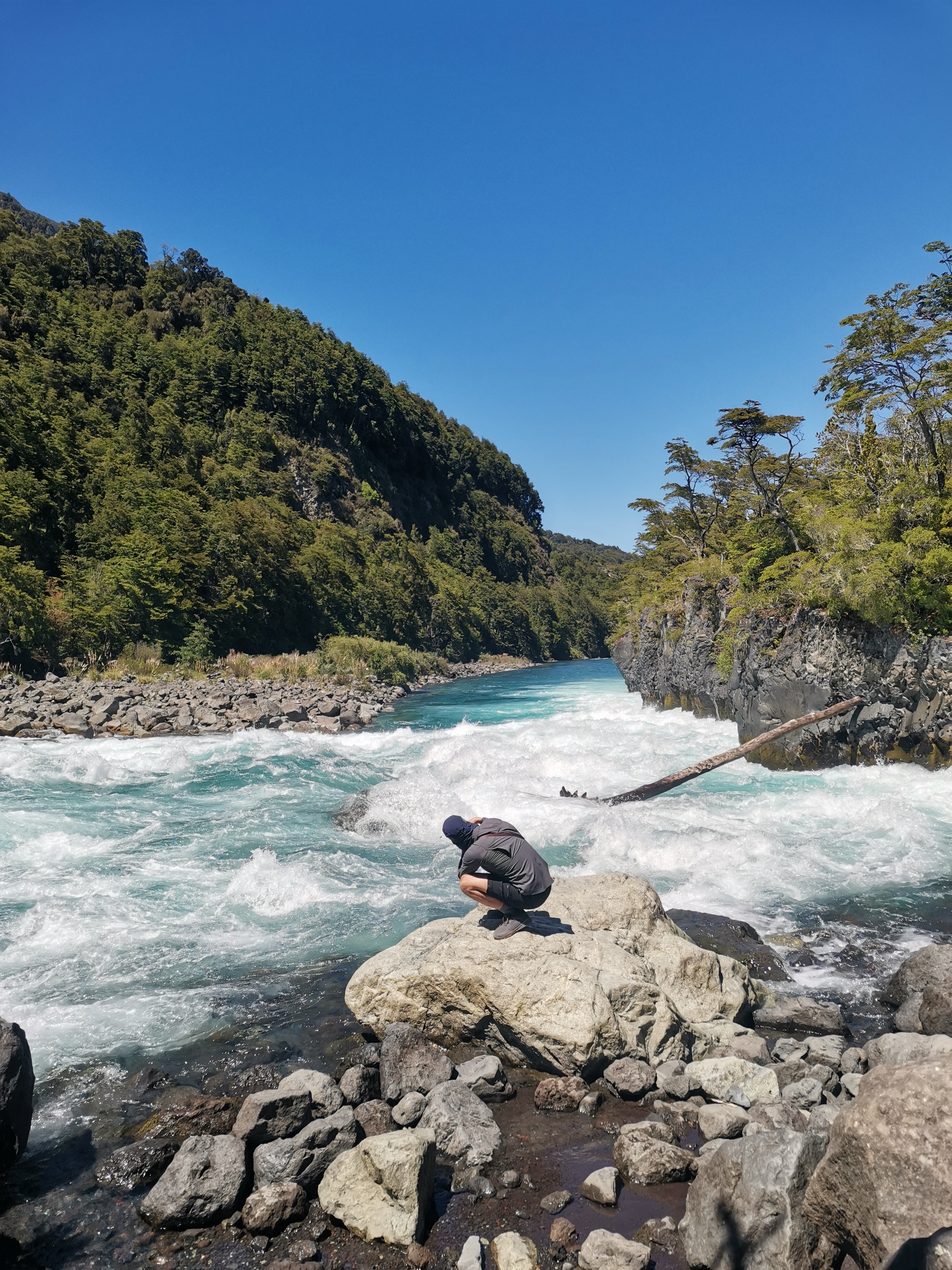
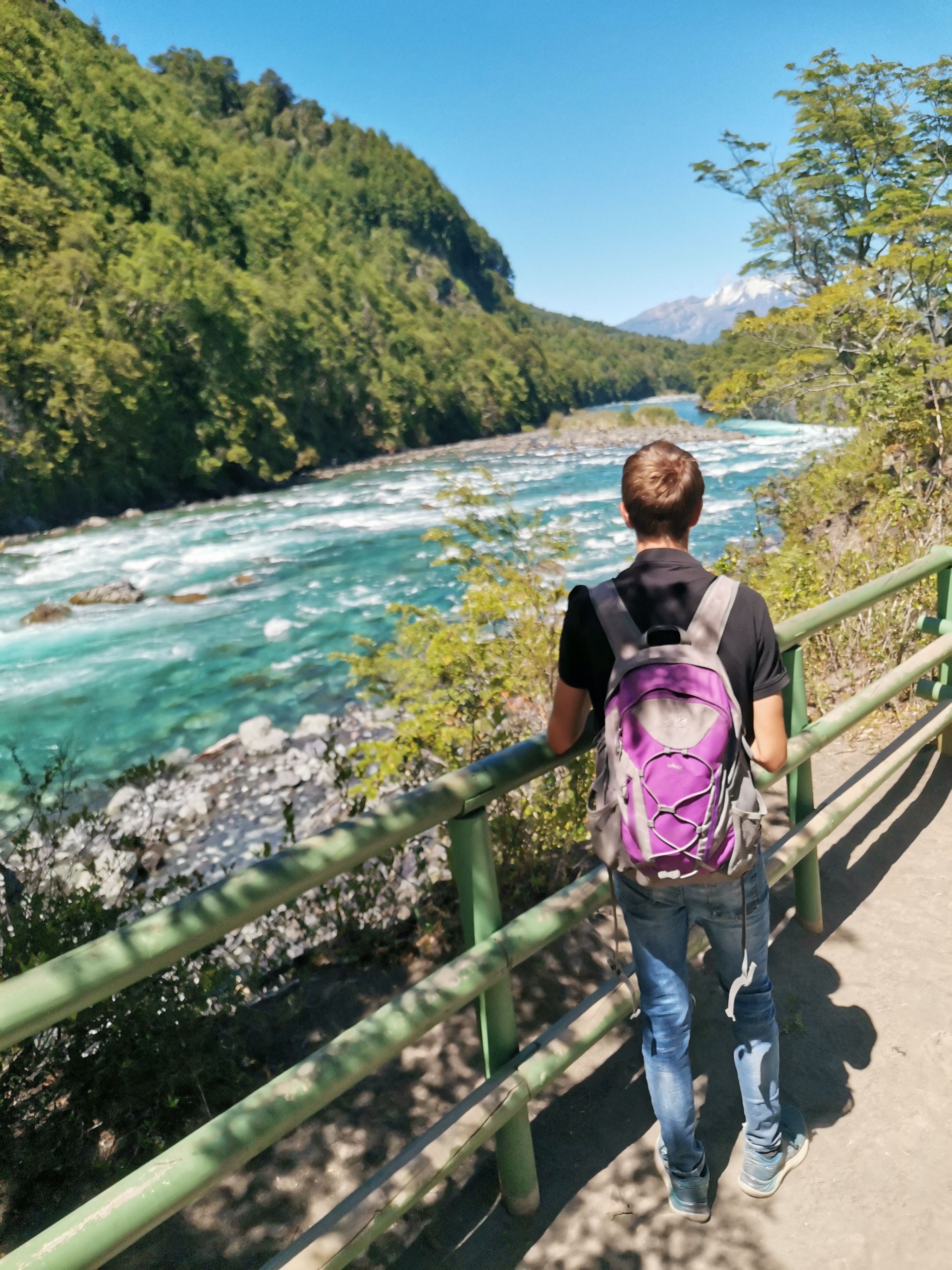
Overview
The Chilean Lake District is home to some out of this World landscapes and scenery, where the blue sky, green forests, icy volcanoes and clear rivers combine in the most intriguing way. Not only are the towns of Pucon and Puerto Varas incredibly welcoming, but they are also ideally located to explore some of Chile's more hidden gems, either as part of the various tours and trips on offer, or on an independent adventure. The Chilean Lake District is certainly not one to be skipped, and is a perfect place to prepare for Patagonian adventures further south.Related.
17th May 2024
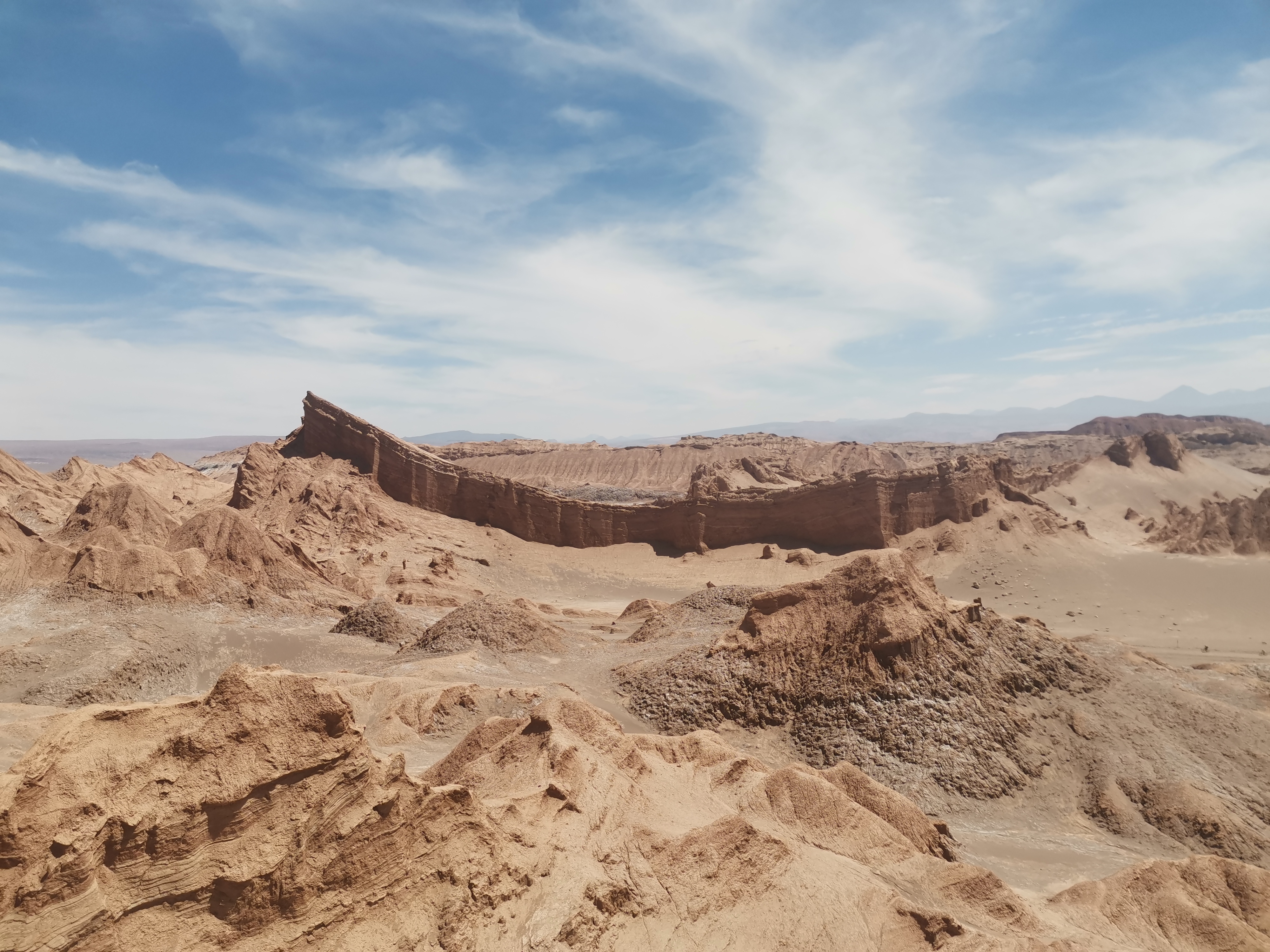
Surrounded by the hostile Atacama desert, San Pedro is a quaint and welcoming oasis, albeit full of tour...
28th May 2023

Chile's capital city doesn't attract many visitors, despite the hoards of tourists who flock to Patagonia...
14th January 2024
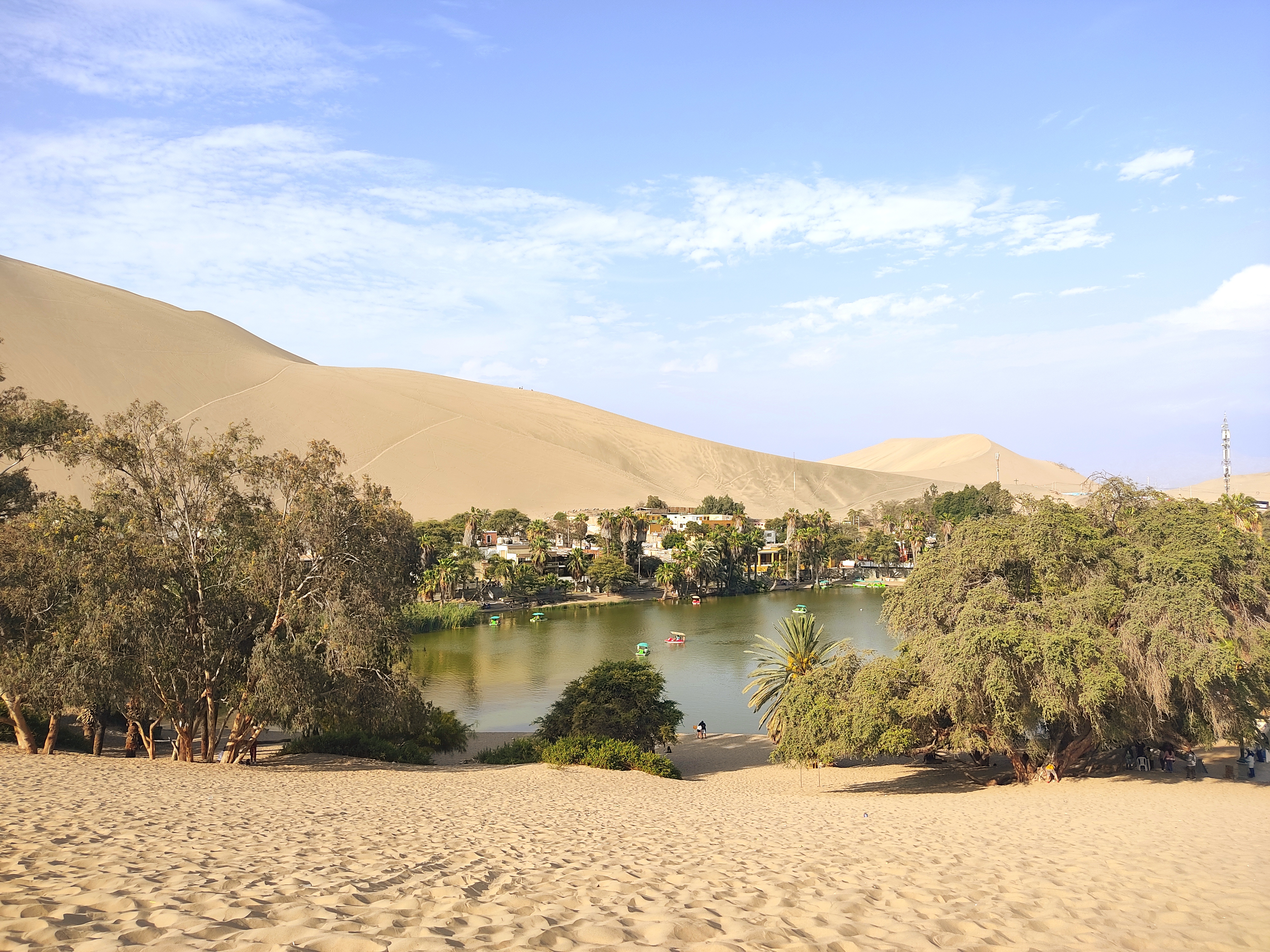
Everyone planning a trip to Peru has heard of Cusco. However, there is so much more to this country, with...


